I unexpectedly developed a passion this year for Nippon Professional Baseball (“NPB”). In America, the popularity of baseball has waned in recent years, especially among younger Americans, who now prefer other sports. I'm 44 years old, I grew up watching baseball, and I still love the sport.
Baseball games in Japan have an atmosphere akin to American college football games, with great fan enthusiasm, chanting and cheering throughout the game, many fans wearing team jerseys, and a fun release of balloons during the “seventh inning stretch.”
Even if you’re not a baseball fan, I highly recommend going to a baseball game if you visit Japan, it’s a great cultural experience.
There are 12 Japanese major league baseball teams, with 13 regularly-used stadiums, because the Osaka-based Orix Buffaloes play a fair number of home games at an alternate stadium in nearby Kobe.
During 2016 I had the pleasure of visiting 10 NPB stadiums in Japan, and in early 2017 I visited the remaining three. I have since been back a few more times.
Here are some photos and observations about the stadiums I have visited. I am ranking the stadiums in order of my own personal preference, but I hope this is helpful to other visitors to Japan who are considering attending a game. Feel free to let me know what observations you agree or disagree with.
1. Koshien Stadium, Osaka (home stadium of Hanshin Tigers)
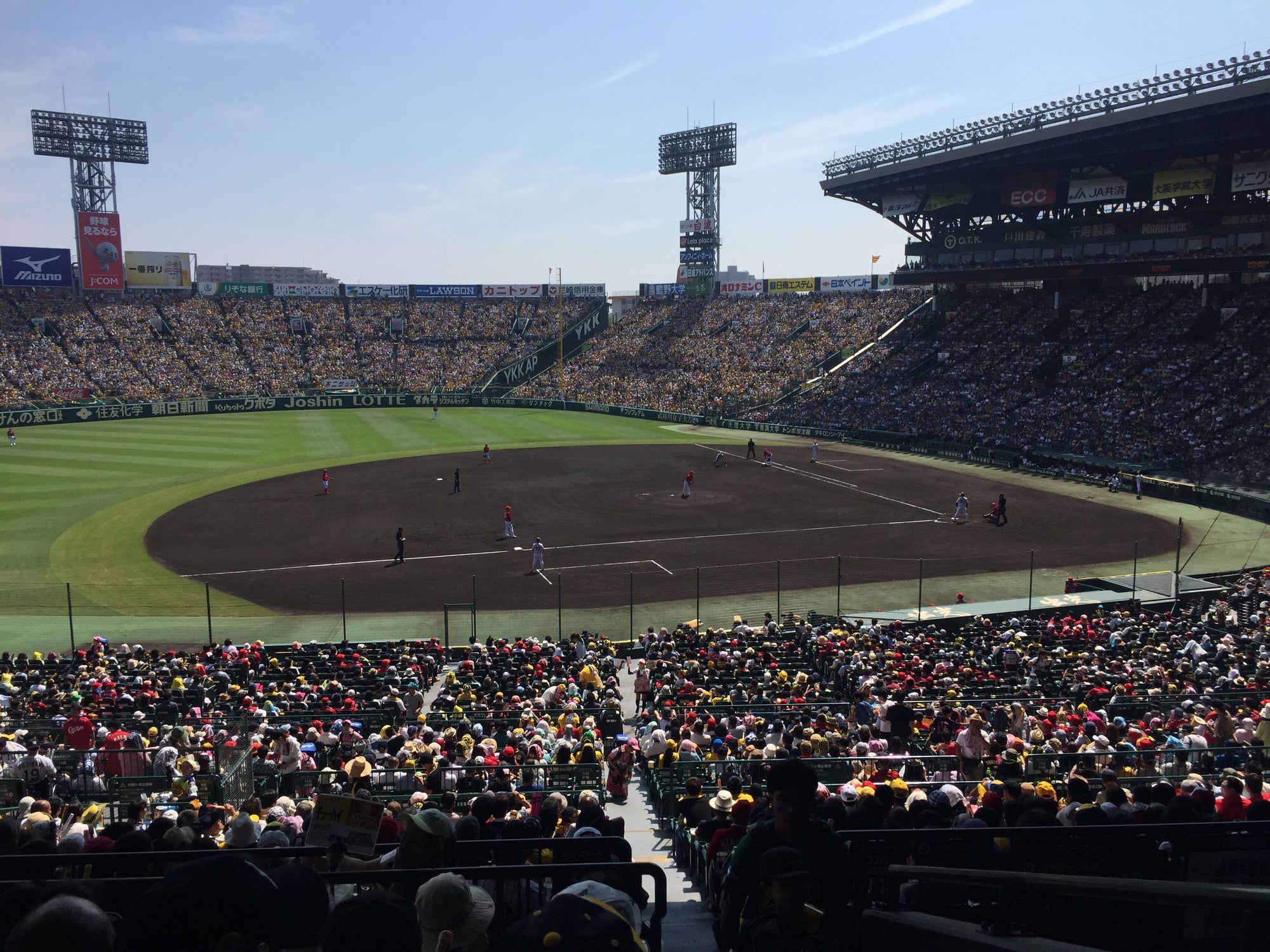
This is the oldest stadium in Japan; it opened in 1924. It features natural grass and a cool all-dirt infield. It looks and smells like a proper baseball park. Think of it as Japan’s Fenway Park.
The fans are very enthusiastic and many games sell out. The probably have the best "7th inning stretch" here, with just about every fan blowing up a yellow balloon and then releasing it into the sky in unison at the end of the song.
Like all Japanese stadiums, it features friendly (mostly female) beer vendors who walk the aisles carrying small kegs of beer on their backs and serve you draft beers at your seat for about 700 yen.
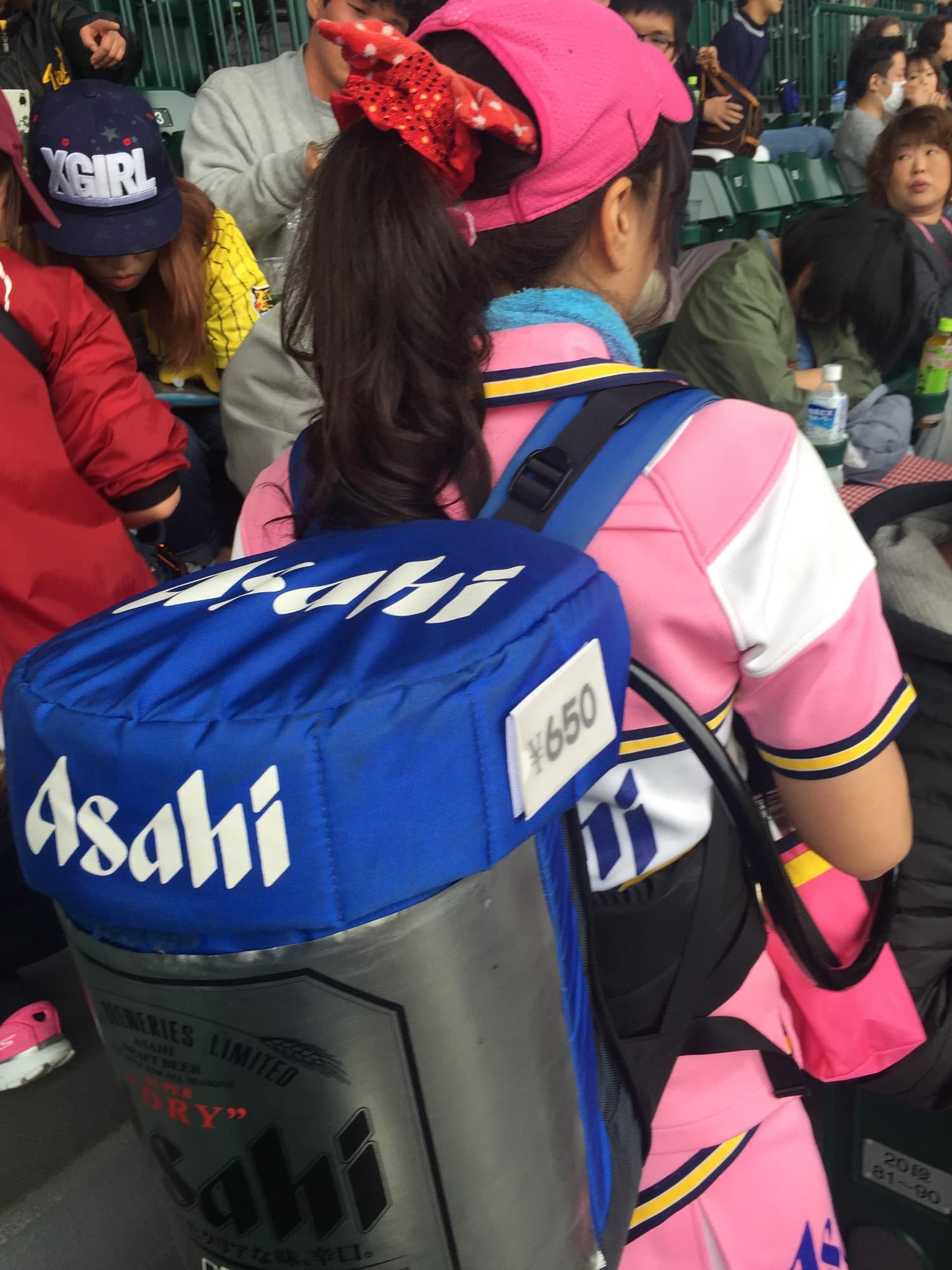
The vendors seem to only sell Asahi beer here, most stadiums give you a wider choice of 3-4 beers. On the plus side, they sell beer well into the ninth inning here.
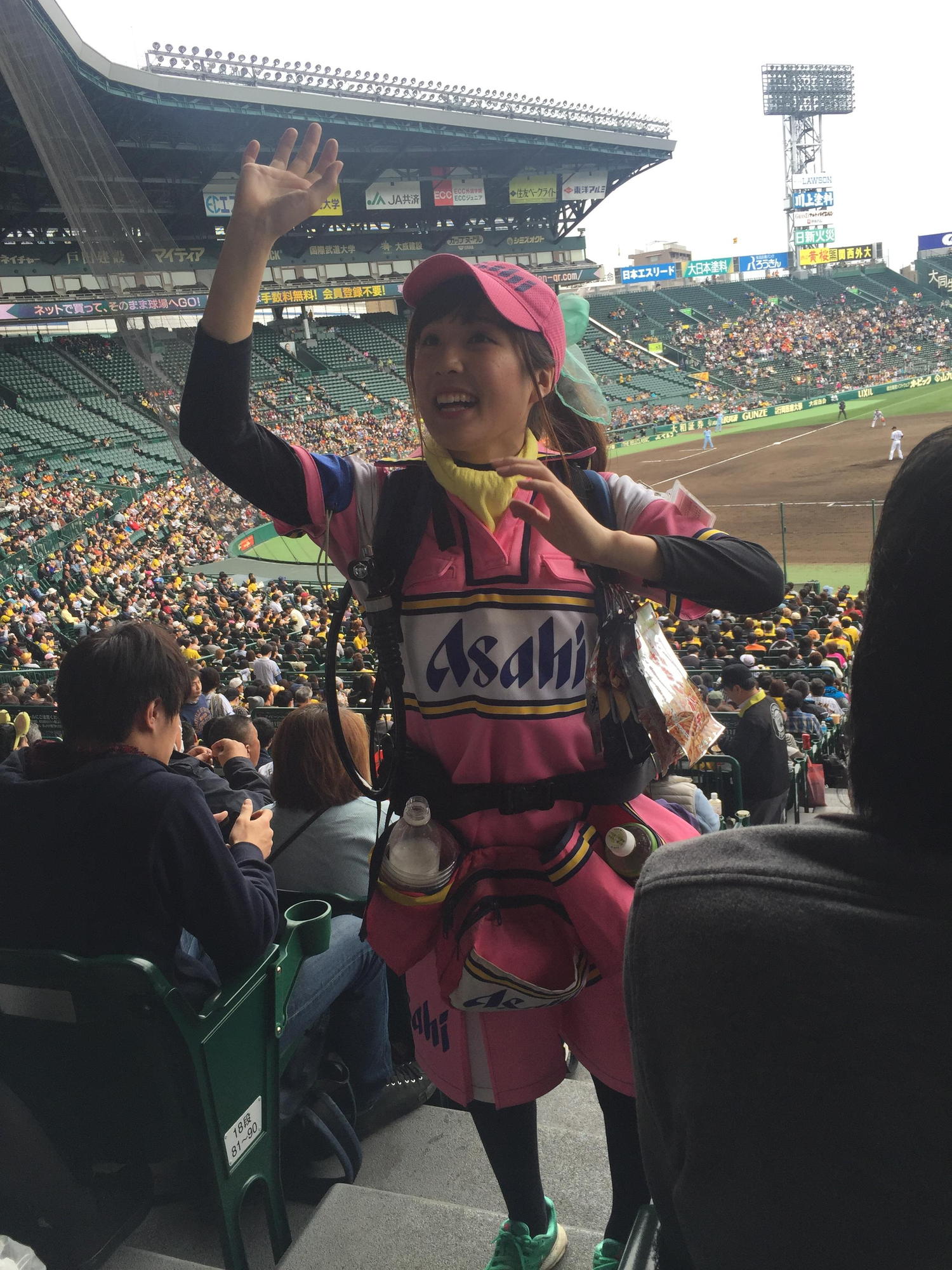
You can easily order tickets from the Hanshin Tigers website and have the QR code emailed to your phone. Then you go to the ticket windows near gate 9 and you'll see several unmanned windows with automated kiosks that will read your QR code and spit out a paper ticket for you.
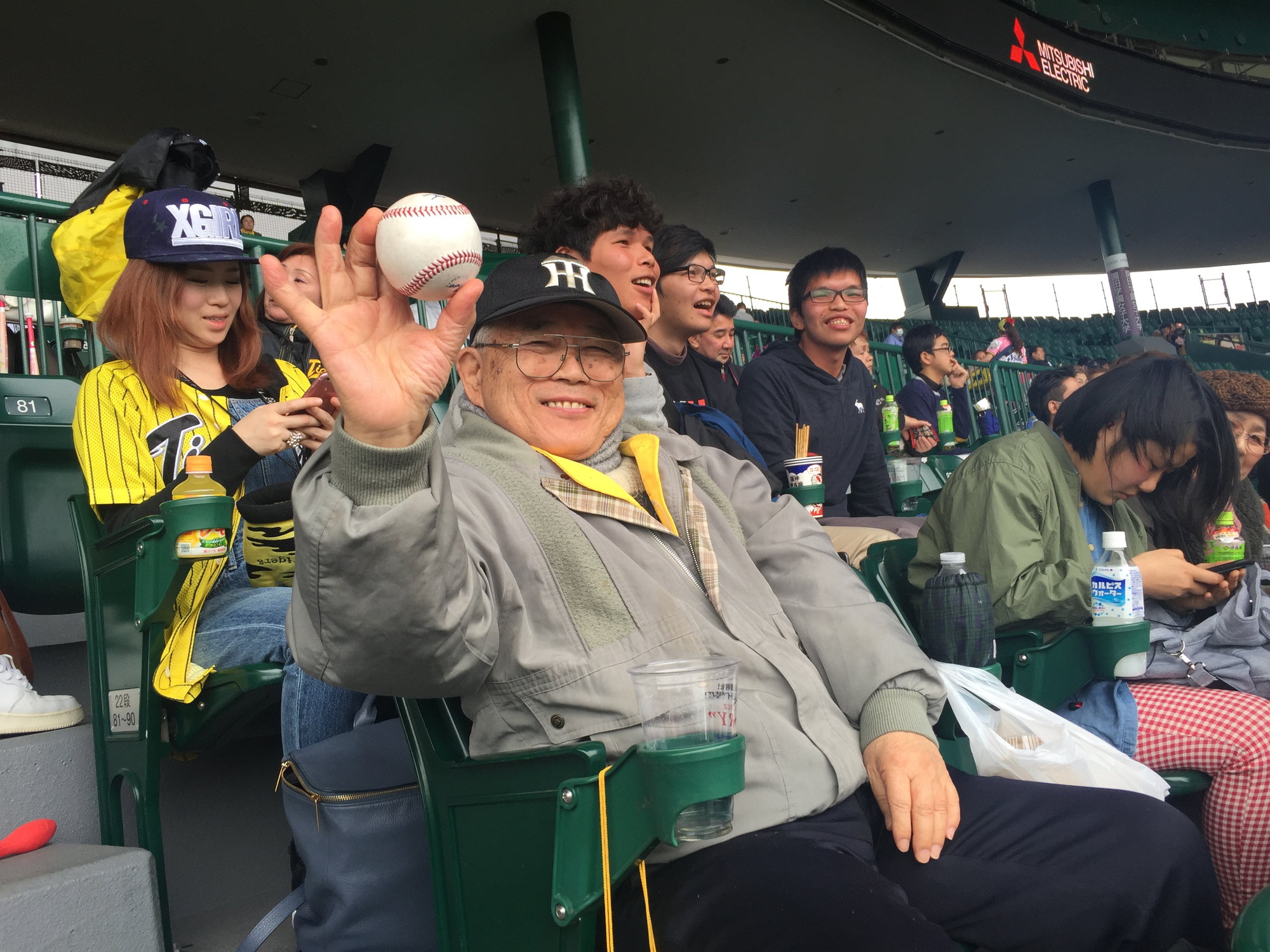
I recommend avoiding the "Alps" seats located well down the right and left field lines, especially the ones closest to the field. If you look at the top photo above you'll see a gate midway down the right field line. The seats to the right of that gate closest to the field have their view of the batter obstructed by the gate. There is a similar gate down the left field line. These are poor seats, with no backing, they are unprotected from the sun during day games, and often rows of these seats remain empty throughout the games because they are so poor. It's better to be higher up, for a better view, and for seats that are covered during day games.
It's easy to get to the stadium, it's about a 20 minute ride on the Hanshin railway from downtown Osaka to Koshien station. The area right around the stadium isn't too attractive though. There's a McDonald's just outside the stadium and a Koshien Stadium museum nearby. Note that the trains get quite crowded right after the game ends as many fans head back to central Osaka. If you're claustrophobic, you may want to leave after the 7th inning stretch to avoid the over crowded trains.
Overall though, due to this stadium's history and charm and passionate fans, I'd rank it as the #1 baseball stadium experience in Japan.
2. Yokohama Stadium, Yokohama (Yokohama BayStars)
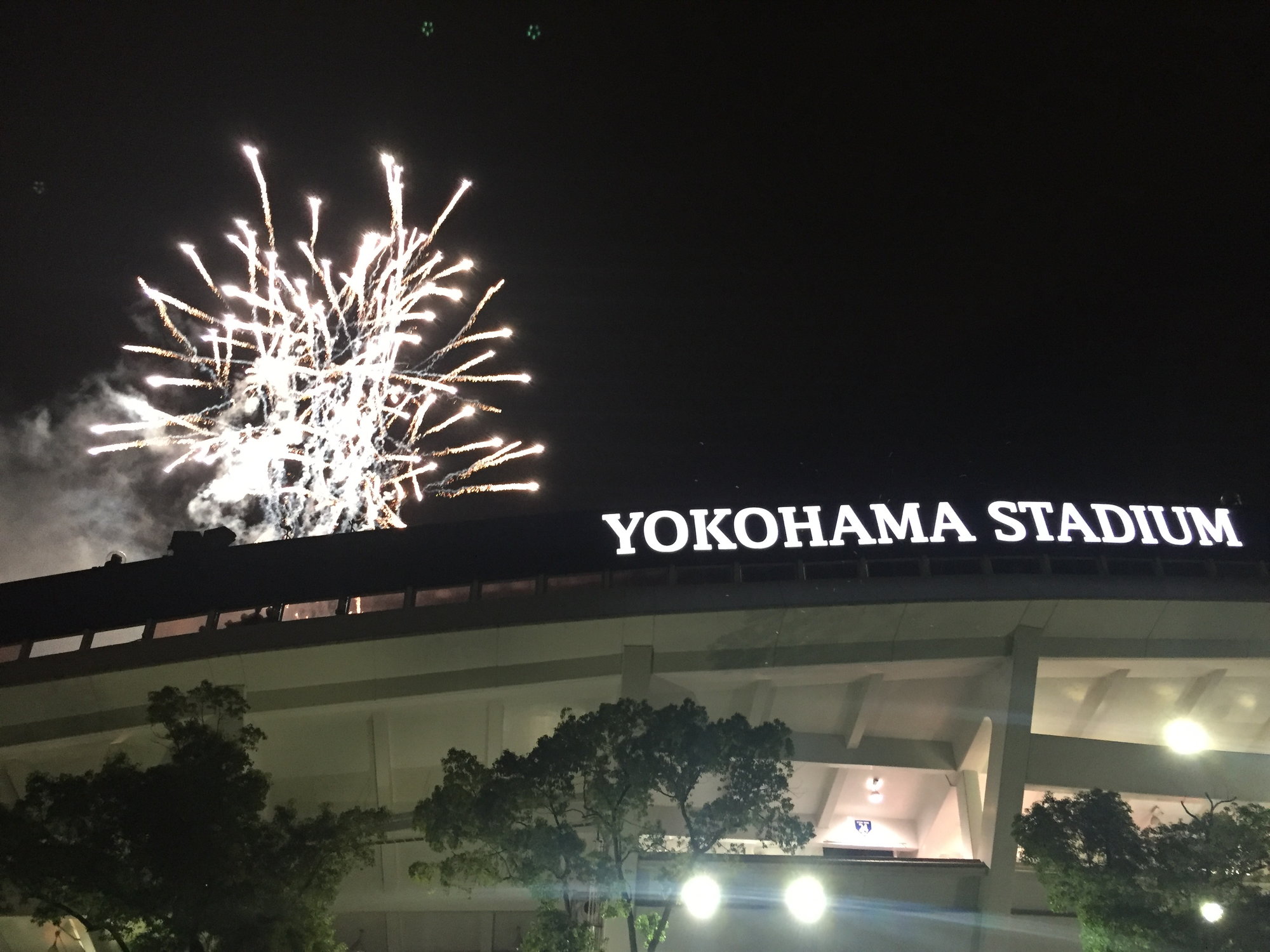
Yokohama Stadium is a great place to see a game. It’s very conveniently located close to bars and restaurants in the heart of Yokohama, not far from the city's attractive waterfront. It’s a small “bandbox” stadium with short distances to the outfield walls and the wind from the bay often blows out, so the games feature more runs scored. There are a lot of home runs hit at Yokohama Stadium, and very few home runs hit at the other NPB stadiums.
This is the most “American-ized” of the stadiums in Japan, and I think it would make a good introduction to Japanese baseball for an English speaker. The large scoreboard features the names and statistics of the players in English and/or the Latin alphabet, which is very helpful to get to know the players. You’ll also hear more English over the P.A. announcements here than at other stadiums.
Many of the Japanese stadiums either don’t sell hot dogs or sell bad hot dogs with weird toppings. Yokohama Stadium actually sells really good hot dogs (near section 17), with great buns, and you can get them plain and just add mustard, in contrast to the flimsy hot dogs with fish toppings or crazy sauces at other stadiums.
Most of the concession stands here also have helpful “point and order” picture menus on the counters. Yokohama Stadium also has some of the best-looking “beer girls” in Japan, and the BayStar Lager craft beer served here is quite good.

The fans here are enthusiastic and fun loving, they sing and cheer throughout the game, it’s a good atmosphere. However, they are not as rabid as fans of the Tigers, Carp, and Giants. They show up late, they leave early, they don't all wear the team colors and jerseys to the game.

I want to offer some suggestions about seat selection at Yohokama Stadium. I usually like to sit in infield box seats either midway down the first base or third base line. At Yokohama Stadium, these these seats are categorized as “S” seats and colored orange and numbered “13” on this map. ???????????????????? ??DeNA??????
In short, although these orange seats (2018 edit: all seats in the stadium now blue) are expensive and close to the field, they are terrible. They are hard, narrow, scoop-type seats like you might find in a bus station waiting room. These seats have insufficient seat pitch to see over the heads of the fans sitting around you. The seats are quite cramped, and if you’re unlucky enough to be sitting next to a rather wide person like I was, you may feel uncomfortably squeezed.
I ended up moving back to the blue “SS” seats and enjoyed a proper, wide fold-down seat and a much better view of the game.

There is no upper deck at Yokohama Stadium. None of the seats have protection from sun and rain. If you go to a day game (usually Saturdays and Sundays) in the summer, the sun can be quite strong and unrelenting, especially if you're sitting on the first base/right field side. I recommend sitting on the third base side where the sun will be behind you. I recently abandoned my sunstroke inducing first base side seats on hot July day, and strategically poached some seats in section 19 down the third base line that were shaded by the light tower behind them. Sweet relief. Seats way up in the top rows on the third base side may provide some sun protection during day games as well. In any event, if you go for a day game in the summertime, wear a hat and sunscreen and sunglasses and consider buying a snazzy Baystars scarf to protect the back of your neck.
Yokohama stadium can easily be accessed in about 30 minutes by train from central Tokyo. When the game ends you can just walk out onto the street and be in the heart of Yokohama with many bars and restaurants around, no need to follow a herd of people and immediately board a jam-packed train just to get away from the stadium.
3. Mazda Zoom Zoom Stadium, Hiroshima (Hiroshima Carp)
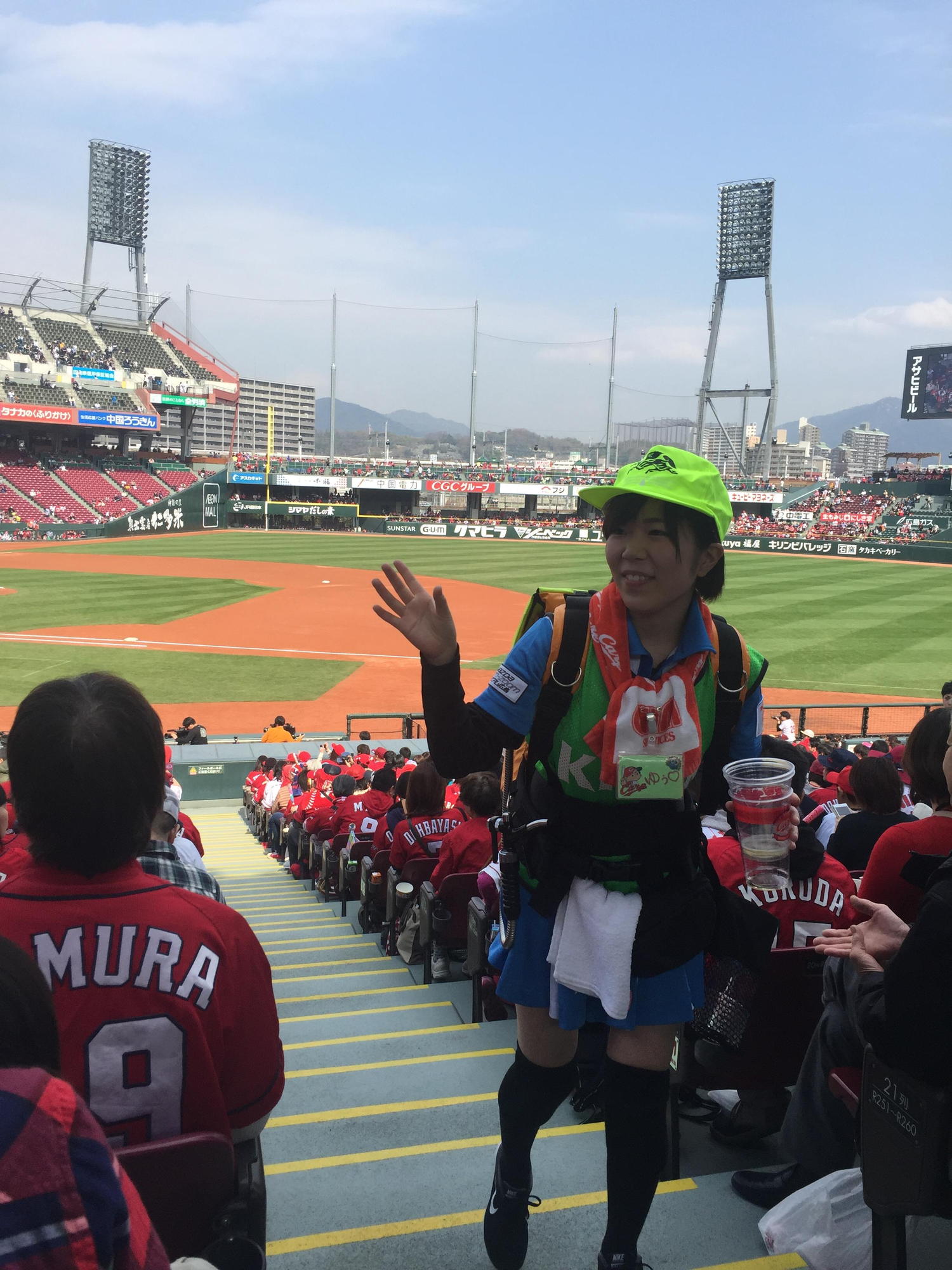
This is the newest NPB stadium, having opened in 2009. It has couple of nice “goods shops” where you can buy Carp merchandise. Most of the fans wear the jerseys of their favorite Carp players.
This place feels like a large American minor-league baseball park, but in a good way. The Carp have a mascot that looks like the Phillie Phanatic.
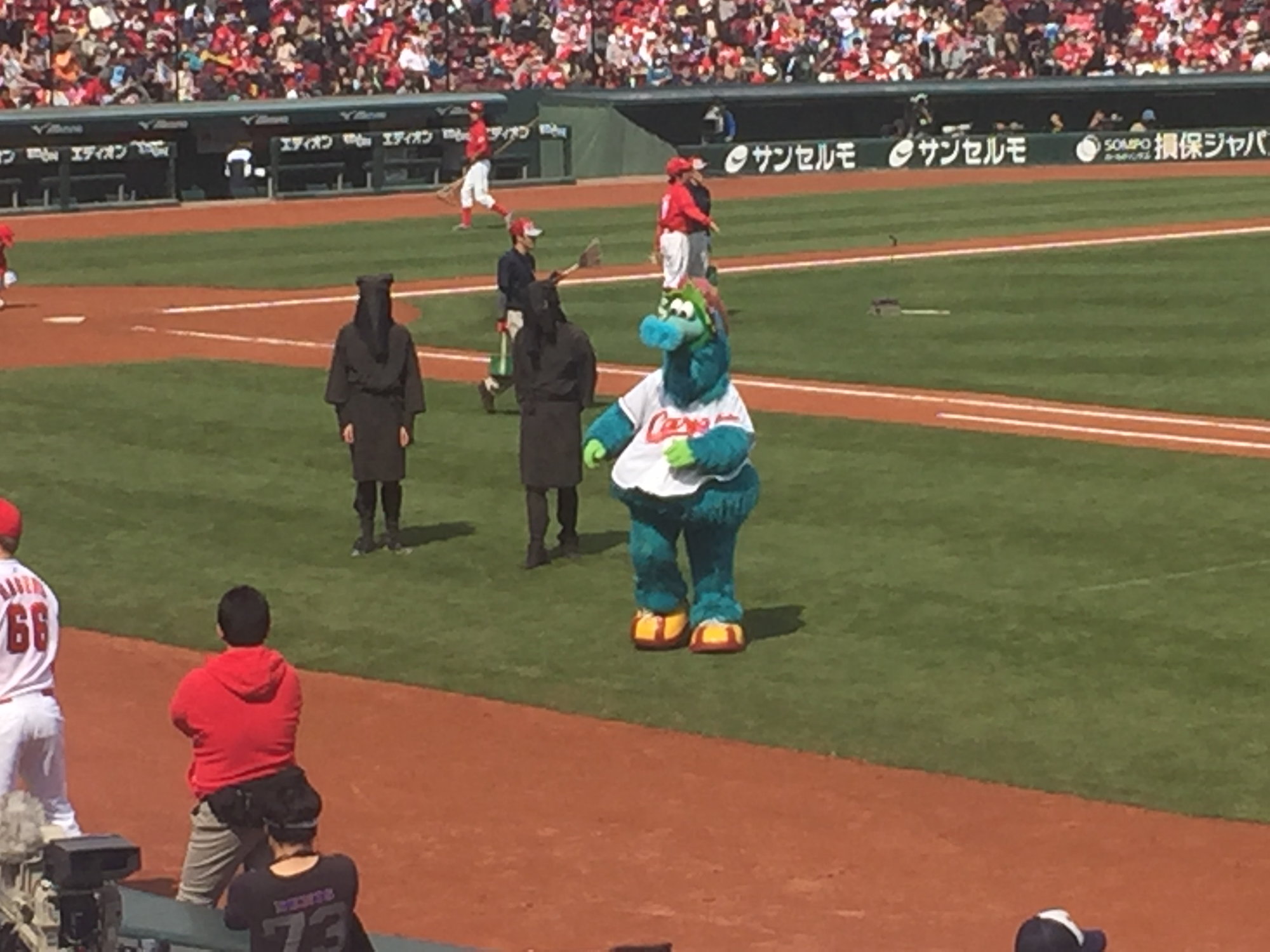
I enjoyed watching the Shinkansen bullet train go by from time to time just beyond left field.
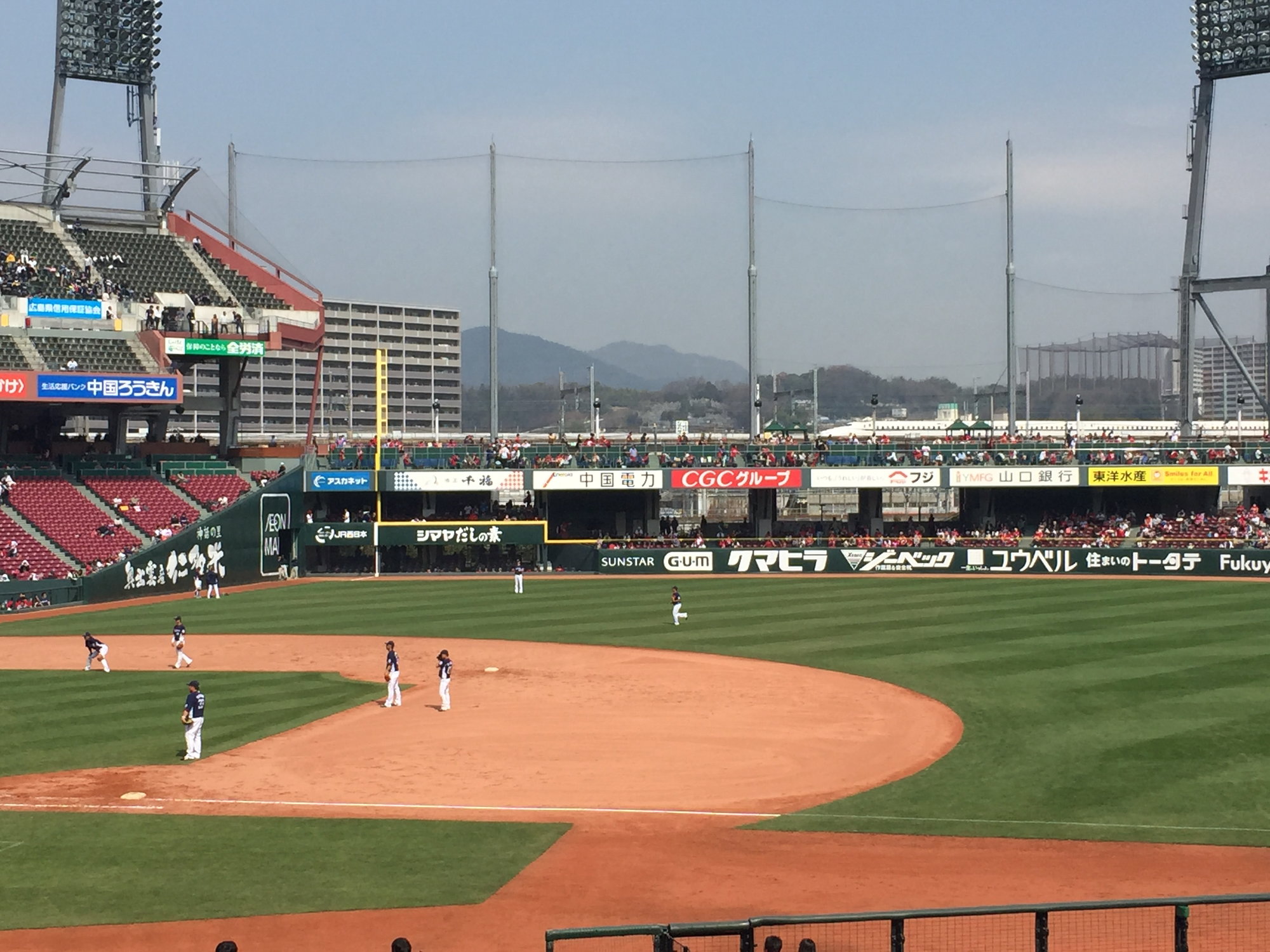
Note that many seats at Carp games are "Uchino" seats. Uchino seats are unreserved, general admission seats in the upper deck behind the infield, actually stretching from midway down the third base line all the way to the right field foul pole. They have no backs, sort of like bleacher seats in the USA, but they are individual curved plastic seats, not one long bench.
If you have Uchino seats for a Carp game, I highly recommend getting to the game at least an hour early, especially if you have a party of multiple people who want to sit together. The first time I had Uchino seats, I arrived about 45 minutes before game time. I walked up to the upper deck and surveyed the Uchino seats and saw thousands of seats that had no one sitting in them. Great! But then looking closer I saw that 90% of the seats were already claimed by people placing a personal item on the seat, like a program, a towel, a cheap souvenir, etc. If there is anything resting on the seat, then it is "taken." If there's nothing on the seat, then the seat is available to sit in.
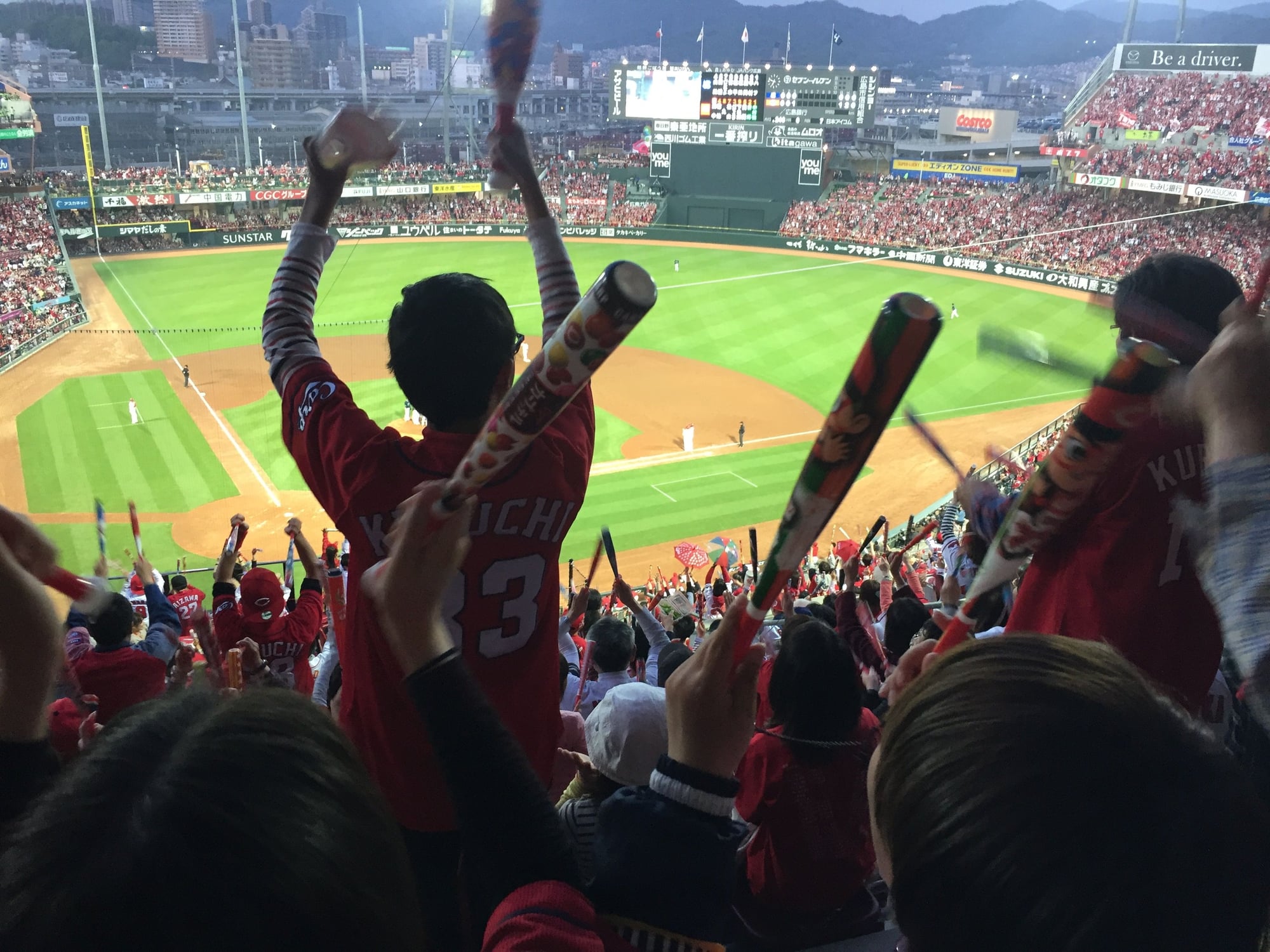
Most of the good Uchino seats close to home plate/over the infield are taken very early. People "save" them and then go for a walk inside (or outside?) the stadium until the game starts, or one family member will arrive at the stadium when the gates open two hours before game time and save seats for his entire party by placing articles of clothing on the surrounding seats. By the time the game starts, it's really hard to find empty Uchino seats because you can't tell when you're looking up at the section which seats are empty and which have been saved with a towel unless you walk all the way up the stairs and get really close and try to look at the seat through the mass of people. Then you'll see the towel on the seat. And you'll have to keep repeating that until you're lucky enough to find an empty seat.
This also means that, if you have an Uchino seat, you're advised to bring some removable article of clothing or cheap personal item to the game so that when you have to go to the toilet, you can put it on your seat to stake your claim. Or in a pinch you can do what I did and just stack your empty beer cups on your seat and then go to the toilet, though that felt a bit crass.
The Carp won the pennant in 2016 and have a passionate fan base with almost everyone decked out in red and white. This is one of the harder tickets to get in Japan, so plan ahead, many Carp games sell out. Their fans also travel very well, tickets at other stadiums are harder to get if the Carp are visiting.
4. Met Life Dome, west of Tokyo (Seibu Lions)
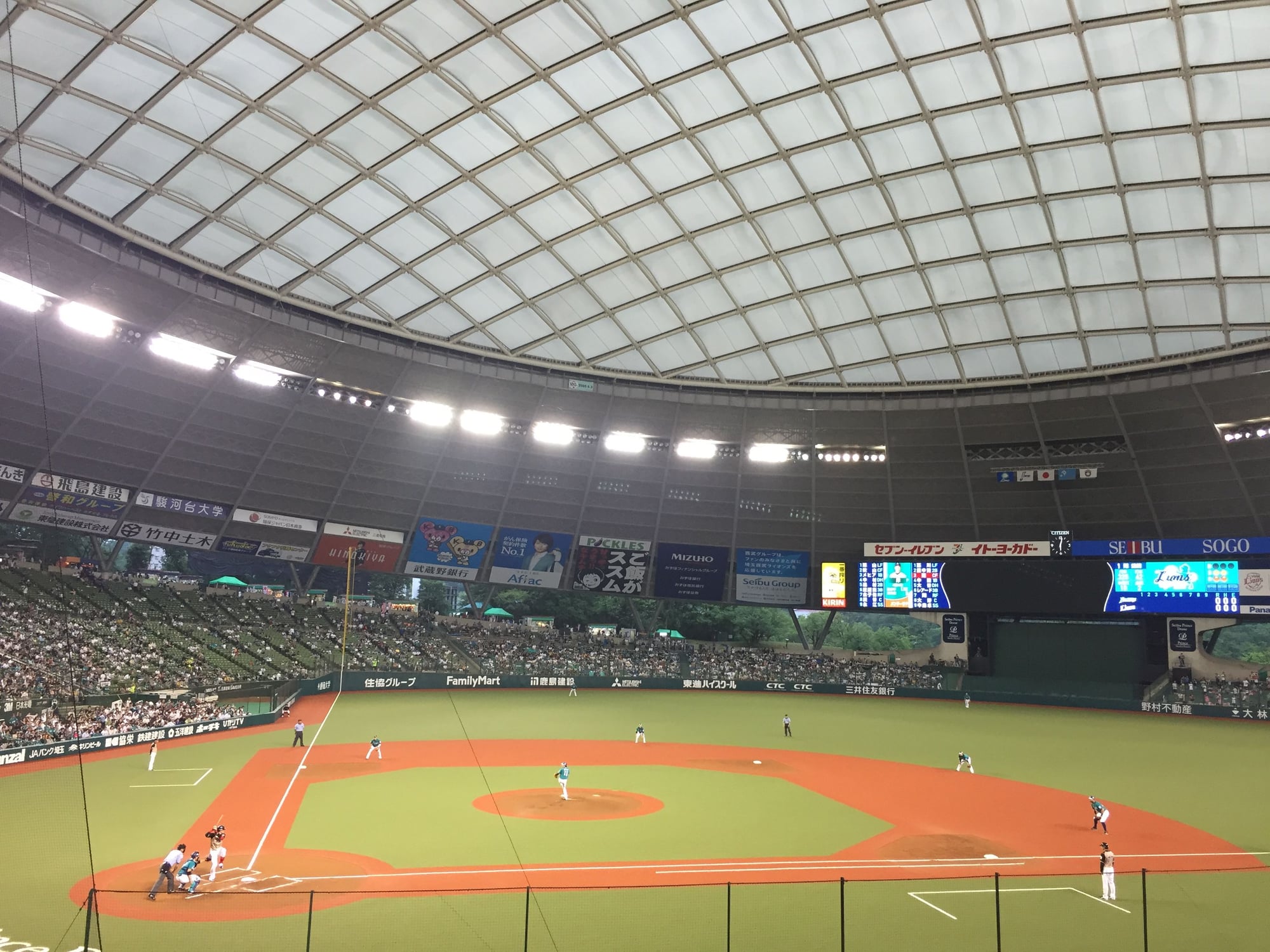
The Seibu Dome, now called the "Met Life Dome" has a special place in my heart, and I’m not sure why. Another online ranking of Japanese baseball stadiums lists the stadium dead last.
Let’s get the main drawback out of the way - the Seibu Dome is inconveniently located at least an hour by train out to the outskirts of Tokyo. There’s nothing interesting to see around the stadium.
Google Maps’ transit feature is very helpful in negotiating the train schedules and train changes required to get there. You will undoubtedly have to change trains several times to get to the stadium, but some of those changes may just involve walking across the platform and into a waiting train towards the stadium. The stadium is located just a few steps outside Seibukyujo-Mae station.
Most weekday games start at 6 p.m., so consider leaving Tokyo before 4:30 so that you’re not spending an hour on jam-packed rush hour trains. The trains from the Seibu Dome back to Tokyo right after the game can also be very crowded, so you might think about leaving the game early, like Dodger fans do, to beat the train “traffic.”
Enough about the trains. Here’s what I like about the Seibu Dome. Even though it’s called a “dome,” the stadium is open to outside air, it just has a cool “Close Encounters of the Third Kind” - looking roof. It's encircled by trees, creating a pleasant view when you're sitting in the stadium looking out. It has a great open layout with an outdoor concourse allowing you to see the whole field whenever you're walking around the stadium, or standing at the concession stands, etc.
They have some good food and beverage outlets, including an American-style bar and grill called “Bricks” located behind the infield box seats, and a nearby cafeteria-type place that serves great french fries.
The beer girls are numerous and friendly and you can even get American beers at Seibu Dome like Coors Light and Budweiser if you’re inclined.

Unfortunately, the Seibu Lions aren’t very good, and their fans aren’t passionate. I've attended three games here, and the games were all sparsely attended. You may have a whole row to yourself. But in overcrowded Tokyo, having a bit of space can be refreshing.

Note that you walk into the stadium entrance near center field, and as you continue on the concourse towards your seats, there are two checkpoints where ushers will stop you before letting you continue toward the infield seats. The first checkpoint is roughly at the foul pole, and the next one is roughly at the first or third base mark.
This means that if you have outfield seats, you can’t get anywhere near the infield seats. However, if you buy “nosebleed” infield seats you can go anywhere, including moving down to the (undoubtedly empty) infield box seats close to the field, once you walk past the second checkpoint.
5. Rakuten Kobo Stadium Miyagi, Sendai (Rakuten Golden Eagles)
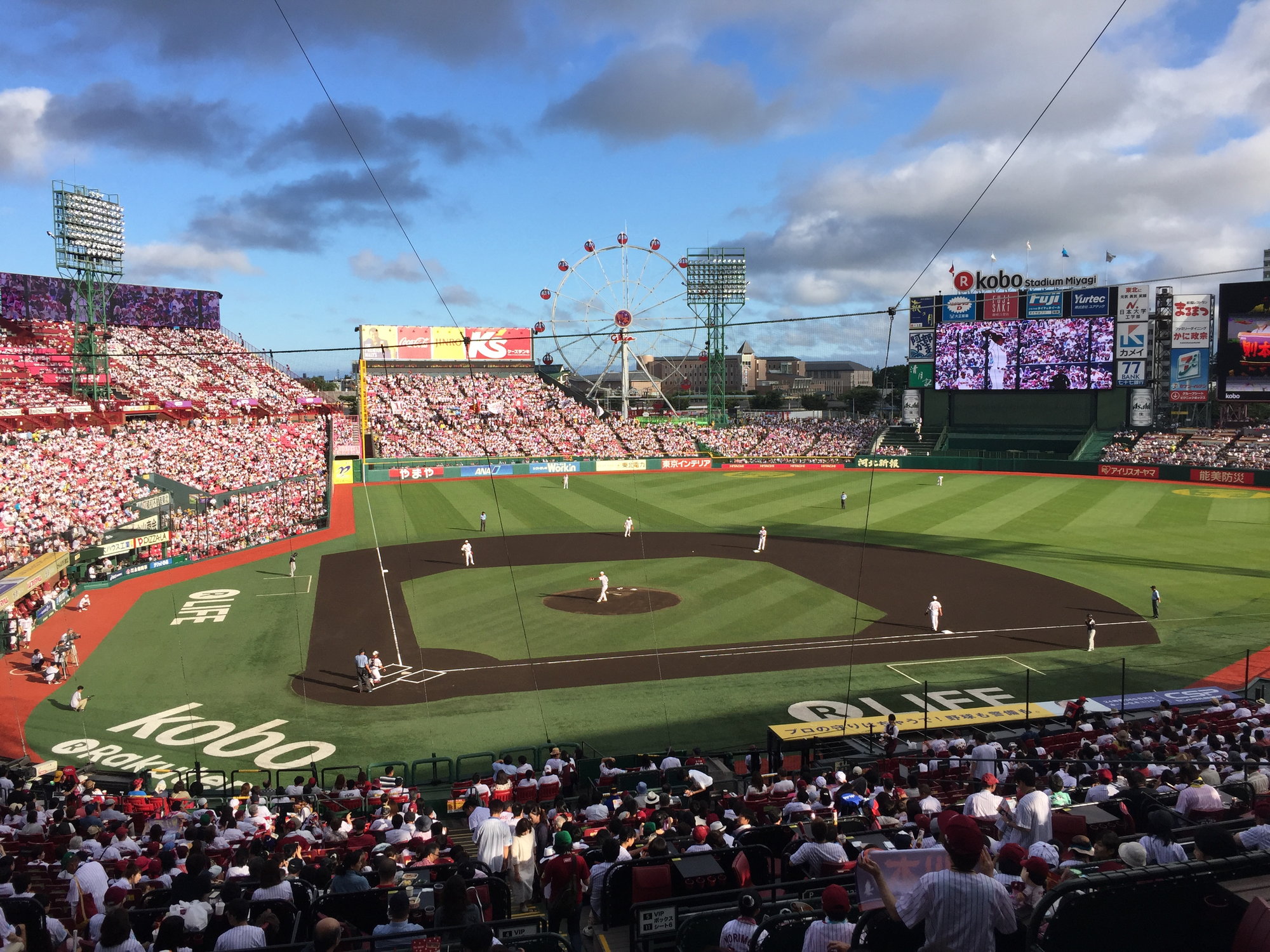
This was the first time I’ve ever been to a baseball game located in an amusement park. There’s a ferris wheel right behind left field. This stadium probably has the largest and best “goods shop” of all, they seem to have jerseys from every player who has ever played for the team.
People were lined up around the corner to taste these delicious balls.

The stadium is well located, you can walk there from downtown Sendai. It’s an old stadium, built in 1950, so it lacks some of the modern “bells and whistles,” but it’s a nice, family-friendly place to watch a game, with one of the few grass fields in the NPB.
6. Tokyo Dome a.k.a. "The Big Egg," Central Tokyo (Yomiuri Giants)

The Yomiuri Giants have been described as the "New York Yankees of Japan" and their domed stadium has been called the "mecca" for baseball fans in Japan. It's worth visiting this stadium just to see the passion of the Giants fans, almost all clad in orange, waving orange towels, and cheering on their team.
The dome is very easy to access in central Tokyo. It's simple to buy tickets on the English-friendly Yomiuri Giants' team website. Note that the Giants are very popular and many games sell out.
There's a good variety of food concession stands and there's no shortage of Giants jerseys and souvenirs for sale.

There are also dedicated smoking rooms in the concourse. Spend an hour in there and you'll age ten years.
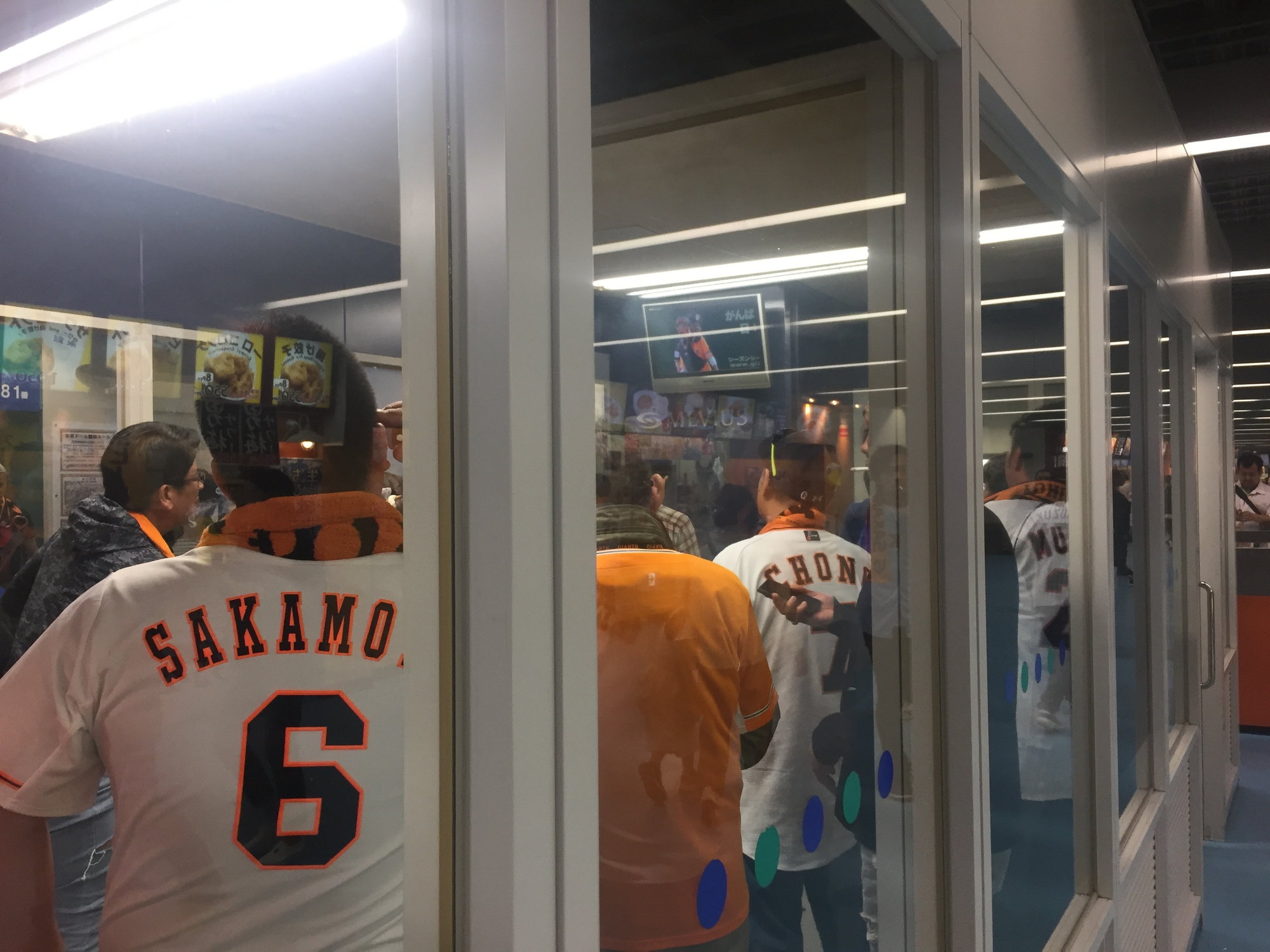
The cheerleading squad is first rate. Beware that a local draft beer from one of the roving vendors will set you back 800 yen, which is a little pricier than at other stadiums.

The Japanese Baseball Hall of Fame is also located in the Tokyo Dome, if you arrive early you can visit it before seeing a game there.
7. ZOZO Marine Stadium, east of Tokyo (Chiba Lotte Marines)

This stadium is located in Chiba, about 30 kilometers east of Central Tokyo. It's a bit of a drag getting here by public transport, especially from Shinjuku, where your hotel may be located.
Google maps doesn't even offer transit directions to ZOZO Marine Stadium. You have to ask the app for directions to Kaihin-Makuhari JR station, the closest station to the stadium.
From Shinjuku, I first took the Marunouchi subway line to Tokyo station in order to connect to the JR Keiyo Line out to Chiba. The walk through Tokyo Station from the subway to JR Keiyo line seemed to take, I don't know, an hour and half. OK, I'm exaggerating. But it's a long walk.
I then stood next to the JR ticket vending machine in Tokyo station for quite a while, staring at the station map on the wall, trying to find Kaihin-Makuhari station so I could figure out the cost of the ticket. I couldn't find it. I finally asked a staff member who told me that the ticket cost 550 yen. I then realized that the station is marked on the map just as "Makuhari."
The JR Keiyo line trains go out to Chiba only every fifteen minutes or so and take 30-35 minutes. Keep an eye out for Cinderella's castle on the right side of the train as you pass Tokyo Disneyland.
When you arrive at Kaihin-Makuhari station, follow the signs toward the stadium, walk straight in the direction of the water as far as you go, cross the overpass over the expressway, then turn right. It's about a twenty minute walk. You'll eventually see the stadium. I made the mistake of turning right too soon and ended up at an events and conference center complex that sort of looks like a baseball stadium from a distance but is not, in fact, a baseball stadium. I had to double back and cross over a few more overpasses before I eventually found the stadium.

I had read warnings online that this stadium gets very cold from the cold winds coming off the water. I brought a jacket and a wore a heavy long sleeve shirt for a day game in early May. I was sweltering. I was sitting about twenty rows back, a bit beyond first base, and the sun was just over the right field foul pole beating down on the right side of face through much of the afternoon. A lot of the fans were wearing towels on their heads to protect them from the sun. I suspect the fans on the third base side had it even worse with the sun right in their eyes.
The upper deck seats directly behind home place are covered, I recommend sitting there, or in the cheering section bleachers, or well up the right field line, if you're attending a day game and you don't want to be in the sun.
Aside from the commute and the day game sun, it's hard to dislike anything about this stadium, but there's nothing particularly unique about it either. My seat was noticeably wide and padded; my American-sized buttocks appreciated that. The facilities are good are good and the crowd is very enthusiastic.
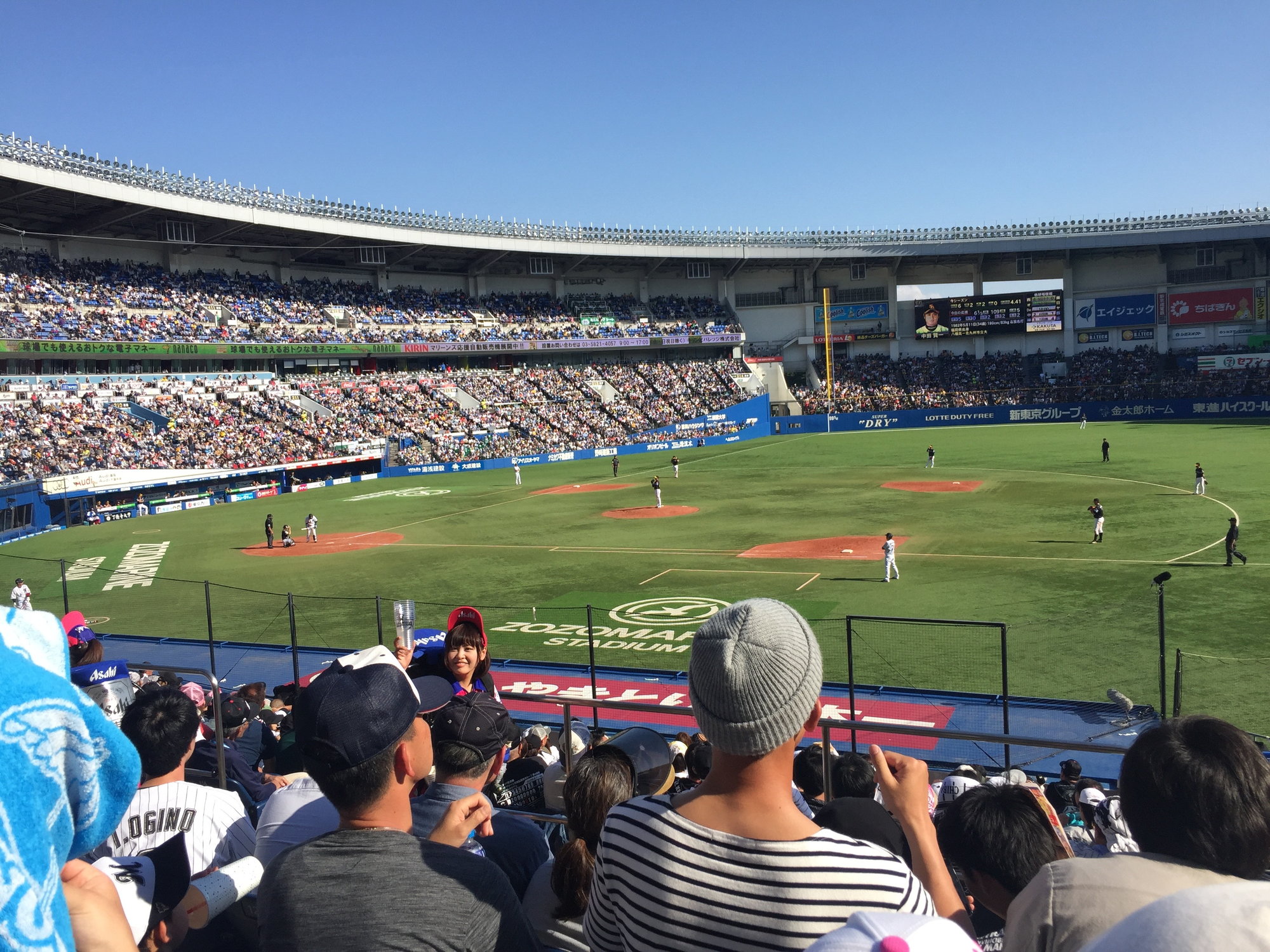
ZOZO Marine Stadium must have the most beer girls per fan of any stadium in Japan. You won't go thirsty here. It seemed that the (attractive) beer girls were walking by my seat on an average of about one every 10-15 seconds. There's a single main lower level concourse around the stadium that the beer girls all walk along (between rows 14 and 15), and it was not uncommon to seem them bottlenecked three or four deep along the concourse and more or less bumping into each other.
Also, they served beer until the last out of the bottom of the ninth inning. I'm not sure if that's because it was a day game, or a holiday, or because this stadium has no cut off time for beer sales. I appreciated the outstanding beer availability.
Staying until the last out was probably a mistake though. It was a close game, almost everyone stayed until the end, and the scrum to exit the stadium was rather uncomfortable. It seemed we were trapped in the back concourse for quite a while and that they didn't have all the exits open for some reason. Once we got outdoors, we were a group of tens of thousands of people all jam packed on the same footpaths slowly shuffling in tight formation for thirty minutes all the way to the train station. This is a stadium you might want to leave early to avoid the crowd.
8. Sapporo Dome, Sapporo (Nippon Ham Fighters)
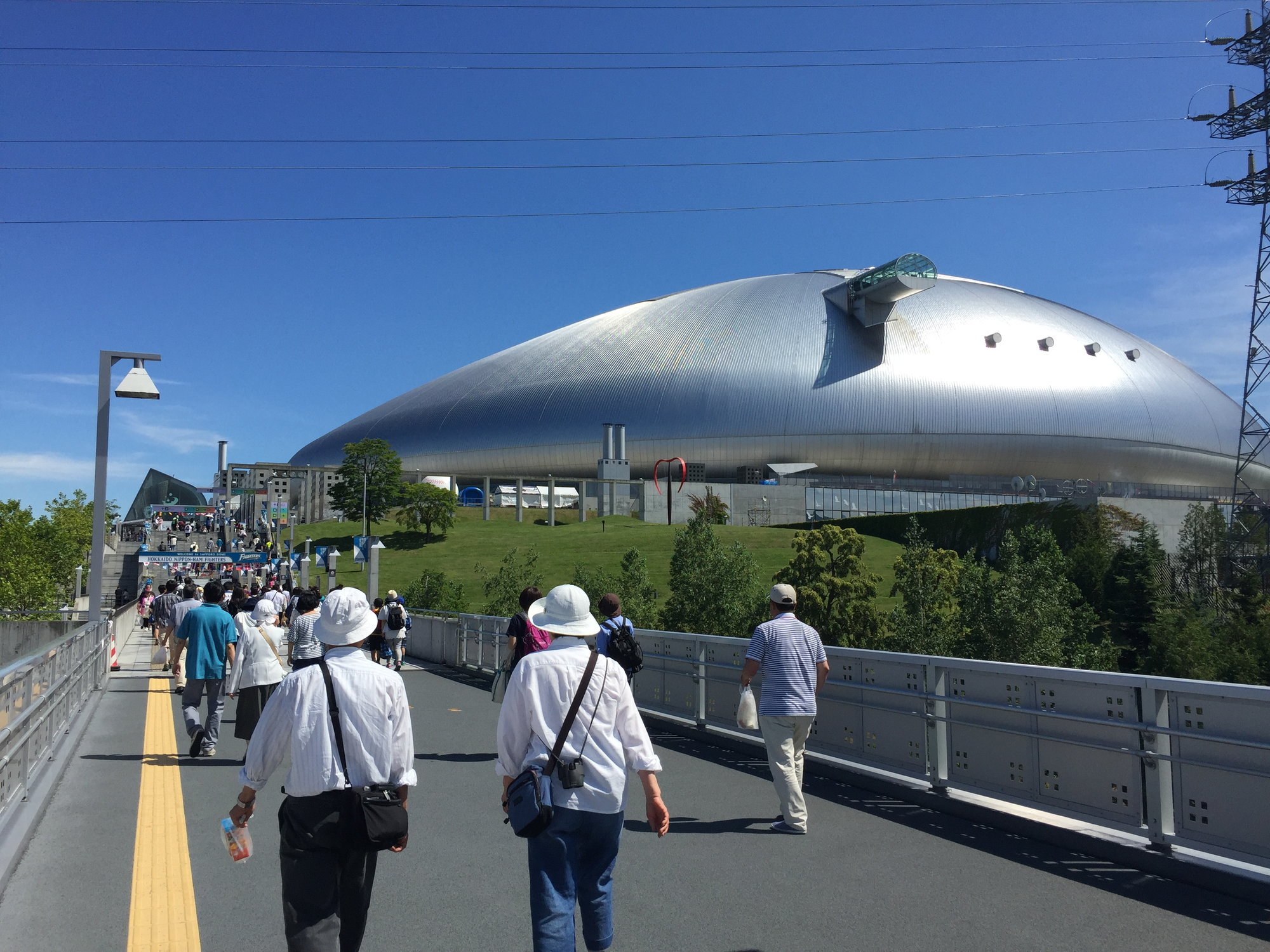
This is the newest domed stadium in Japan and probably the best of the true domes. I personally believe that baseball was meant to be played outdoors on natural grass, so I don’t love watching baseball games in domes. This one has a good scoreboard, cheerleaders who dance in the stands between innings, and, of course, dancing robots.

You can easily buy tickets from the Fighters’ website and just show the QR code on your phone to enter.
Like in Yokohama, some of the infield box seats very close to the field aren't that good. I felt like I was sitting in a basin in my first base box seats. I'd recommend sitting 15+ rows back if you have infield box seats here.
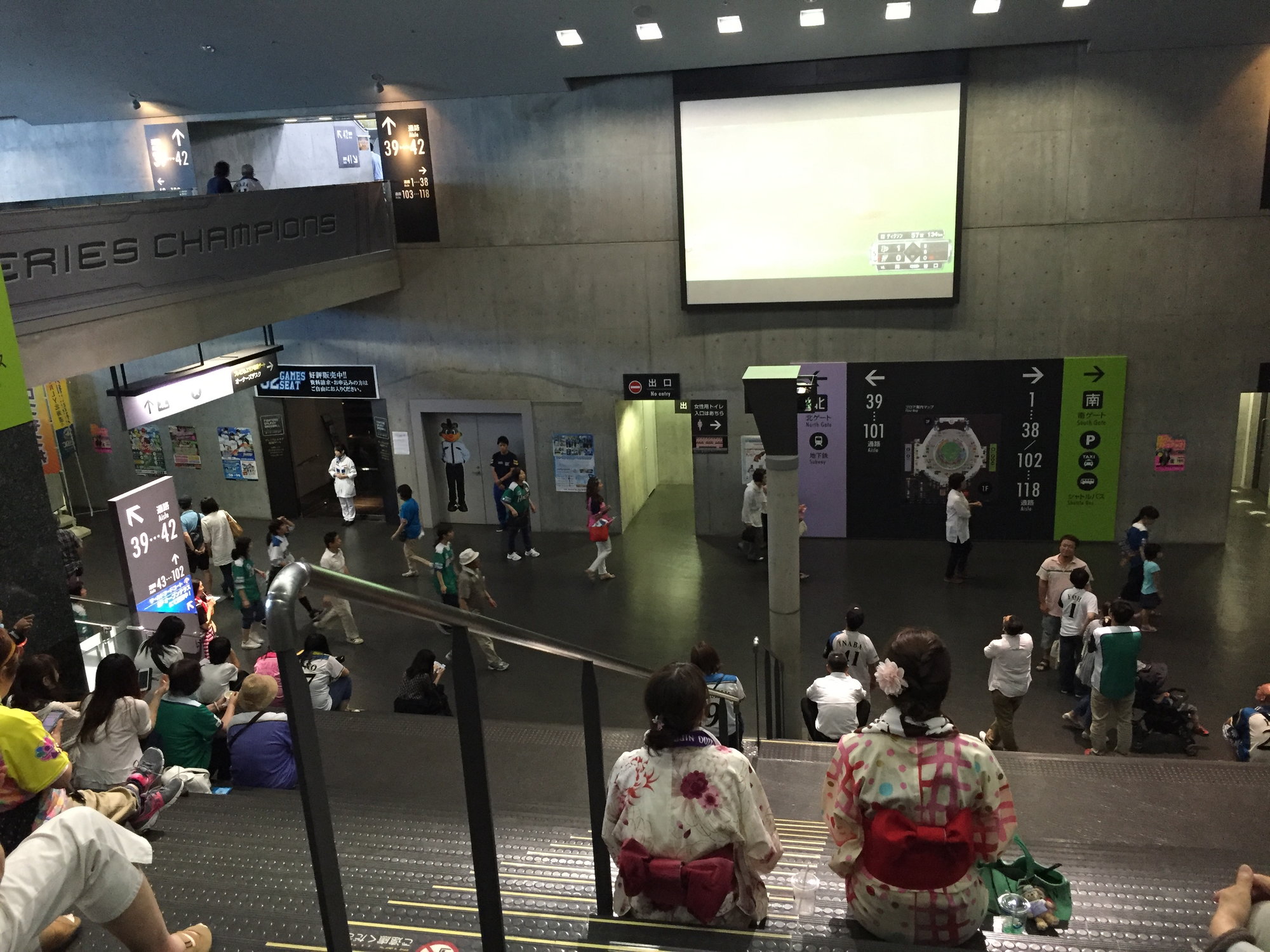
The Fighters are a very good team and feature the most talked about player in Japan, Shohei Otani. He’s a 22 year old phenom who hits well for power and average and also pitches at more than 100 mph. See him before he signs for tens of millions of dollars with an American major league baseball team. [2018 edit: Too late. He's now an Anaheim Angel.]
9. Hotto Motto Field, Kobe (Orix Buffaloes)
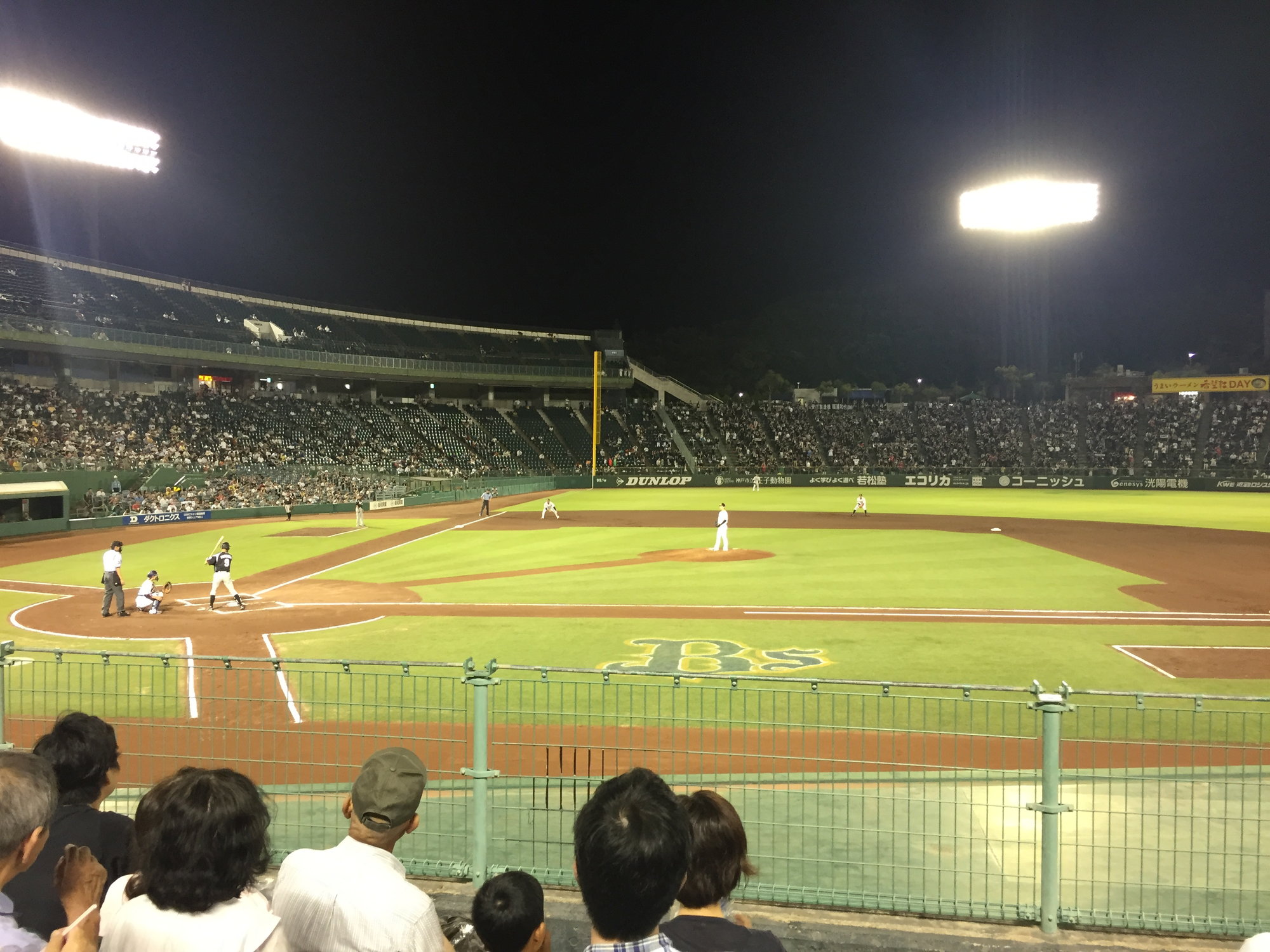
The Orix Buffaloes play a significant minority of their homes games here. Wikipedia says that this stadium was built in 1988 and holds 35,000 fans, it seems much smaller and older than that, and it reminded me of an American minor league or college baseball stadium. It does feature natural grass.
The food, beverage, and merchandise outlets are very limited. Hotto Motto seemed to have the fewest beer girls and they only sold Suntory beer, which is not a good beer, in my opinion.
On the plus side, this stadium doesn’t have much of the annoying, ubiquitous netting that sometimes covers/blocks many of the infield box seats at other Japanese stadiums. As long as you’re not right behind home plate, any row above row 5 will put you above the netting and give you an unobstructed view of the game.

If you’re coming from Osaka, you’ll transfer between the train and the subway to the stadium at Kobe’s Sannomiya station. There’s a good bar/restaurant/nightlife area around Sannomiya that’s worth visiting after the game.
10. Meiji Jingu Stadium, Shinjuku, Tokyo (Yakult Swallows)
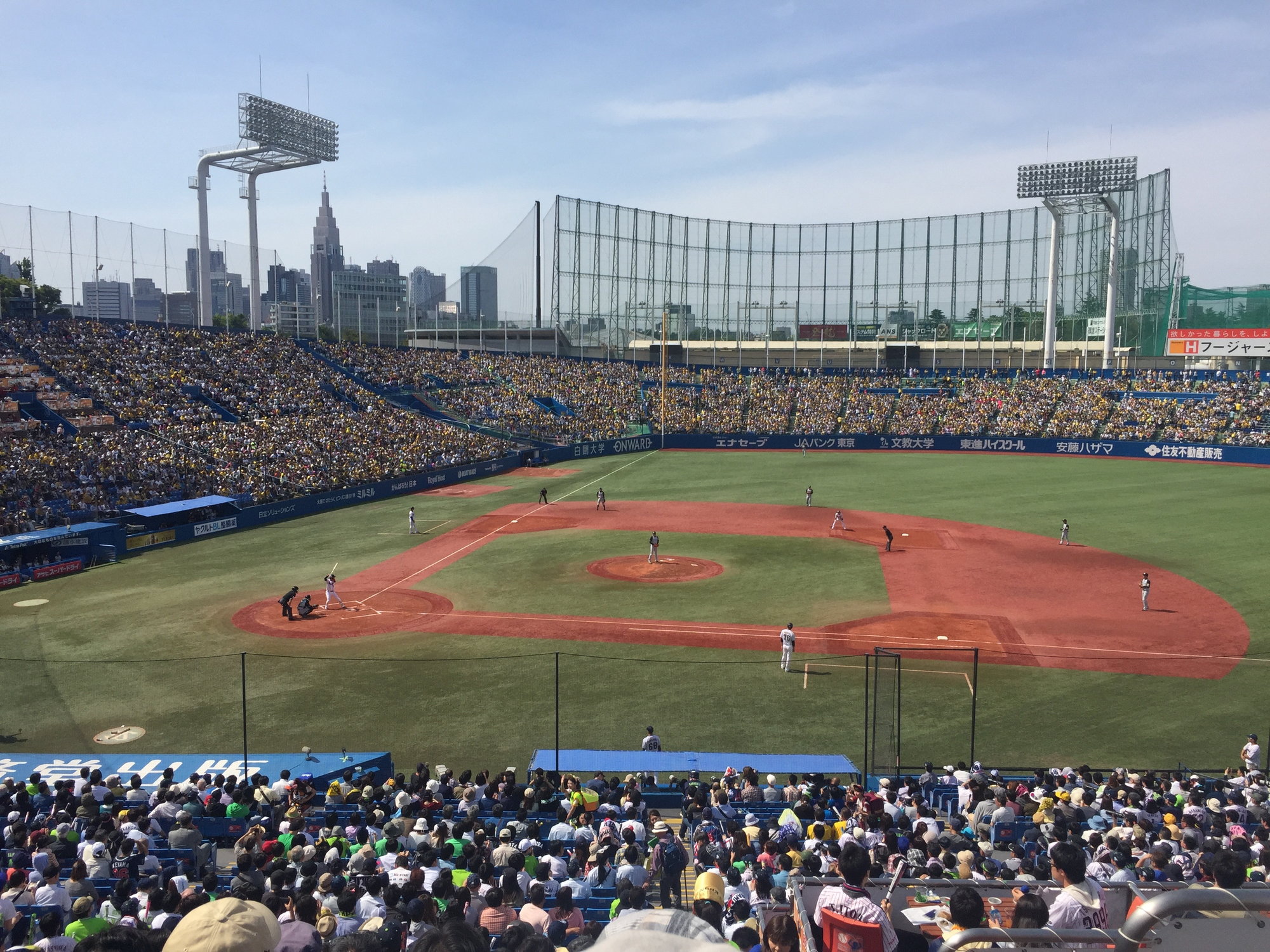
This is the second oldest baseball stadium in Japan; it opened in 1926. I thought it would have that old-time baseball park charm, like Koshien Stadium. It doesn't.
For starters, the artificial turf field looks like the faded green felt of an old pool table that's been left outside a frat house for a couple of summers. The stadium otherwise reminded me of a cookie-cutter stadium built in the USA in the 1970's, not the 1920's.
Though lacking in antiquated charm, the stadium is also burdened with the downsides of being a 90 year-old stadium, like cramped corridors and an insufficient number of concession stands and toilets, leading to long lines for both. Note that you have to enter Meiji Jingu stadium at the precise gate designated on your ticket, because there are barriers between many sections. If you walk in the wrong gate like I did, the only way to get to your seat is to plead stupidity to an usher and have him escort you on the "walk of shame" back outside the stadium and then back inside past the bemused ticket takers who are manning the gate that you should have entered.
Like at many Japanese ballparks, there's a lot of netting along the baselines, so if you want box seats but don't want to watch the game through a net, I recommend getting tickets at least 30 rows back.
The Swallows fans also seemed more subdued to me than other home crowds. I attended two games here during "Golden Week," and the visiting Hanshin Tigers fans were louder and more enthusiastic than the Swallows fans at both games. Even the official "goods shop" outside the stadium selling Swallows' gear was small and disappointing.
Maybe part of the problem here is that Swallows' fans celebrate when their team scores a run not by screaming and stomping and clapping but by doing an "umbrella dance," where they just raise their little umbrellas up and down, up and down. They also do this during the seventh-inning stretch. It's rather silly, they need a new schtick.
On a positive note, Meiji Jingu stadium is well located in Tokyo's foreigner-friendly district of Shinjuku. The stadium is easy to access, and Swallows' star Tetsuto Yamada is one of the most exciting young players in Japan.
11. Fukuoka Dome, Fukuoka (Fukuoka Soft Bank Hawks)

The Fukuoka Dome has the best scoreboard in Japan. It’s actually four adjoining scoreboards that stretch across the whole outfield. Fukuoka has a very good team and great fan participation, led by the “Honey Hawks” cheerleaders.

The Fukuoka Dome is the home of the 2017 Japan Series champions, the Fukuoka Soft Bank Hawks. The stadium is inconveniently located a bit far from downtown next to the Hilton Sea Hawk Hotel. There used to be a “Hawks Town” mall next to the dome, but that has closed now, supposedly for “renovations.” The ushers don’t seem to check tickets at all, so you might be able to buy cheap seats and then move down and poach better seats, at least until the place fills up.
It has the standard food and beverage offerings, including KFC and Mos Burger. But while the Yokohama Stadium beer girls look like university students or aspiring models, the numerous Fukuoka Dome beer girls mostly look like indentured 12 year olds. Not good.
For more information on buying tickets for and attending a Fukuoka Hawks game, see this excellent review here: http://everybodyhatesatourist.net/tr.../#.WSQSjhPytE4
12. Kyocera Dome aka the Osaka Dome, Osaka (Orix Buffaloes)

This is where the Orix Buffaloes play most of their home games. It’s a characterless dome but with a neat ceiling that looks like sort of like the Death Star.
It’s conveniently located in central Osaka, not far from the Namba entertainment and dining district.
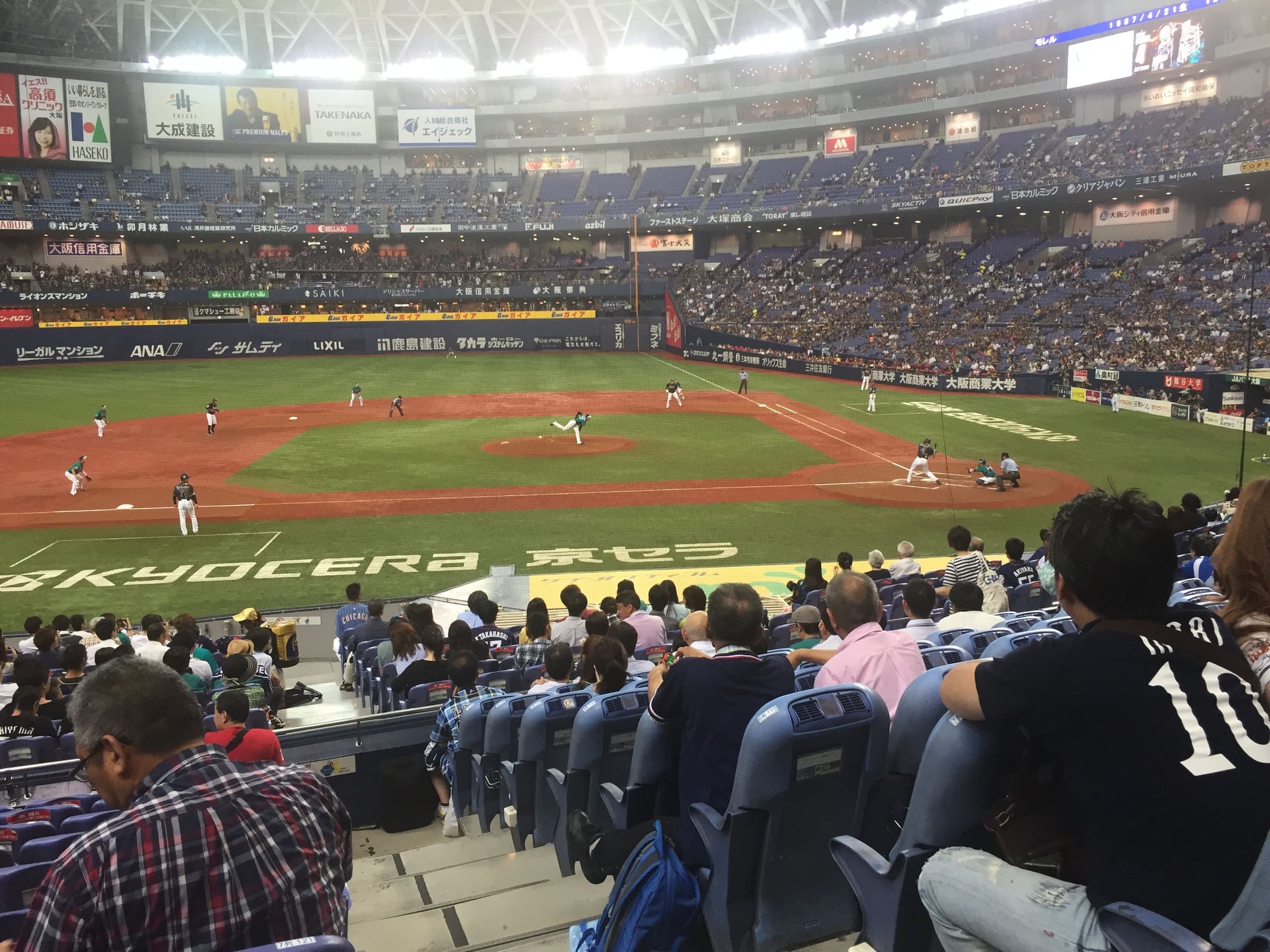
The Kyocera Dome is modern, it has a nice goods shop and a good scoreboard. There’s way too much netting covering many of the infield box seats. The Orix Buffaloes are not a good team and don’t draw many fans, so you can almost certainly show up and get a ticket on the spot. Or you can easily buy tickets for Orix Buffaloes home games here or in Kobe from the team's website and have the QR code sent right to your phone.
13. Nagoya Dome, Nagoya (Chunichi Dragons)

Last and certainly least is the Nagoya Dome. A bad stadium befitting a truly bad team. Netting, more netting, a stupid pink dragon mascot, and empty seats in ugly pastel colors. The worse part? It's in Nagoya.

These scoreboard graphics appear to be from my old Commodore 64. I can’t recommend the place at all.

If you enjoyed this post, please check out another ranking of NPB stadiums here: http://www.stadiumjourney.com/news/0...dium-rankings/ and this guide to visiting Japanese baseball stadiums here: https://thetruejapan.com/tokyo-baseb...-of-the-crowd/
Baseball games in Japan have an atmosphere akin to American college football games, with great fan enthusiasm, chanting and cheering throughout the game, many fans wearing team jerseys, and a fun release of balloons during the “seventh inning stretch.”
Even if you’re not a baseball fan, I highly recommend going to a baseball game if you visit Japan, it’s a great cultural experience.
There are 12 Japanese major league baseball teams, with 13 regularly-used stadiums, because the Osaka-based Orix Buffaloes play a fair number of home games at an alternate stadium in nearby Kobe.
During 2016 I had the pleasure of visiting 10 NPB stadiums in Japan, and in early 2017 I visited the remaining three. I have since been back a few more times.
Here are some photos and observations about the stadiums I have visited. I am ranking the stadiums in order of my own personal preference, but I hope this is helpful to other visitors to Japan who are considering attending a game. Feel free to let me know what observations you agree or disagree with.
1. Koshien Stadium, Osaka (home stadium of Hanshin Tigers)

This is the oldest stadium in Japan; it opened in 1924. It features natural grass and a cool all-dirt infield. It looks and smells like a proper baseball park. Think of it as Japan’s Fenway Park.
The fans are very enthusiastic and many games sell out. The probably have the best "7th inning stretch" here, with just about every fan blowing up a yellow balloon and then releasing it into the sky in unison at the end of the song.
Like all Japanese stadiums, it features friendly (mostly female) beer vendors who walk the aisles carrying small kegs of beer on their backs and serve you draft beers at your seat for about 700 yen.

The vendors seem to only sell Asahi beer here, most stadiums give you a wider choice of 3-4 beers. On the plus side, they sell beer well into the ninth inning here.

You can easily order tickets from the Hanshin Tigers website and have the QR code emailed to your phone. Then you go to the ticket windows near gate 9 and you'll see several unmanned windows with automated kiosks that will read your QR code and spit out a paper ticket for you.

I recommend avoiding the "Alps" seats located well down the right and left field lines, especially the ones closest to the field. If you look at the top photo above you'll see a gate midway down the right field line. The seats to the right of that gate closest to the field have their view of the batter obstructed by the gate. There is a similar gate down the left field line. These are poor seats, with no backing, they are unprotected from the sun during day games, and often rows of these seats remain empty throughout the games because they are so poor. It's better to be higher up, for a better view, and for seats that are covered during day games.
It's easy to get to the stadium, it's about a 20 minute ride on the Hanshin railway from downtown Osaka to Koshien station. The area right around the stadium isn't too attractive though. There's a McDonald's just outside the stadium and a Koshien Stadium museum nearby. Note that the trains get quite crowded right after the game ends as many fans head back to central Osaka. If you're claustrophobic, you may want to leave after the 7th inning stretch to avoid the over crowded trains.
Overall though, due to this stadium's history and charm and passionate fans, I'd rank it as the #1 baseball stadium experience in Japan.
2. Yokohama Stadium, Yokohama (Yokohama BayStars)

Yokohama Stadium is a great place to see a game. It’s very conveniently located close to bars and restaurants in the heart of Yokohama, not far from the city's attractive waterfront. It’s a small “bandbox” stadium with short distances to the outfield walls and the wind from the bay often blows out, so the games feature more runs scored. There are a lot of home runs hit at Yokohama Stadium, and very few home runs hit at the other NPB stadiums.
This is the most “American-ized” of the stadiums in Japan, and I think it would make a good introduction to Japanese baseball for an English speaker. The large scoreboard features the names and statistics of the players in English and/or the Latin alphabet, which is very helpful to get to know the players. You’ll also hear more English over the P.A. announcements here than at other stadiums.
Many of the Japanese stadiums either don’t sell hot dogs or sell bad hot dogs with weird toppings. Yokohama Stadium actually sells really good hot dogs (near section 17), with great buns, and you can get them plain and just add mustard, in contrast to the flimsy hot dogs with fish toppings or crazy sauces at other stadiums.
Most of the concession stands here also have helpful “point and order” picture menus on the counters. Yokohama Stadium also has some of the best-looking “beer girls” in Japan, and the BayStar Lager craft beer served here is quite good.

The fans here are enthusiastic and fun loving, they sing and cheer throughout the game, it’s a good atmosphere. However, they are not as rabid as fans of the Tigers, Carp, and Giants. They show up late, they leave early, they don't all wear the team colors and jerseys to the game.

I want to offer some suggestions about seat selection at Yohokama Stadium. I usually like to sit in infield box seats either midway down the first base or third base line. At Yokohama Stadium, these these seats are categorized as “S” seats and colored orange and numbered “13” on this map. ???????????????????? ??DeNA??????
In short, although these orange seats (2018 edit: all seats in the stadium now blue) are expensive and close to the field, they are terrible. They are hard, narrow, scoop-type seats like you might find in a bus station waiting room. These seats have insufficient seat pitch to see over the heads of the fans sitting around you. The seats are quite cramped, and if you’re unlucky enough to be sitting next to a rather wide person like I was, you may feel uncomfortably squeezed.
I ended up moving back to the blue “SS” seats and enjoyed a proper, wide fold-down seat and a much better view of the game.

There is no upper deck at Yokohama Stadium. None of the seats have protection from sun and rain. If you go to a day game (usually Saturdays and Sundays) in the summer, the sun can be quite strong and unrelenting, especially if you're sitting on the first base/right field side. I recommend sitting on the third base side where the sun will be behind you. I recently abandoned my sunstroke inducing first base side seats on hot July day, and strategically poached some seats in section 19 down the third base line that were shaded by the light tower behind them. Sweet relief. Seats way up in the top rows on the third base side may provide some sun protection during day games as well. In any event, if you go for a day game in the summertime, wear a hat and sunscreen and sunglasses and consider buying a snazzy Baystars scarf to protect the back of your neck.
Yokohama stadium can easily be accessed in about 30 minutes by train from central Tokyo. When the game ends you can just walk out onto the street and be in the heart of Yokohama with many bars and restaurants around, no need to follow a herd of people and immediately board a jam-packed train just to get away from the stadium.
3. Mazda Zoom Zoom Stadium, Hiroshima (Hiroshima Carp)

This is the newest NPB stadium, having opened in 2009. It has couple of nice “goods shops” where you can buy Carp merchandise. Most of the fans wear the jerseys of their favorite Carp players.
This place feels like a large American minor-league baseball park, but in a good way. The Carp have a mascot that looks like the Phillie Phanatic.

I enjoyed watching the Shinkansen bullet train go by from time to time just beyond left field.

Note that many seats at Carp games are "Uchino" seats. Uchino seats are unreserved, general admission seats in the upper deck behind the infield, actually stretching from midway down the third base line all the way to the right field foul pole. They have no backs, sort of like bleacher seats in the USA, but they are individual curved plastic seats, not one long bench.
If you have Uchino seats for a Carp game, I highly recommend getting to the game at least an hour early, especially if you have a party of multiple people who want to sit together. The first time I had Uchino seats, I arrived about 45 minutes before game time. I walked up to the upper deck and surveyed the Uchino seats and saw thousands of seats that had no one sitting in them. Great! But then looking closer I saw that 90% of the seats were already claimed by people placing a personal item on the seat, like a program, a towel, a cheap souvenir, etc. If there is anything resting on the seat, then it is "taken." If there's nothing on the seat, then the seat is available to sit in.

Most of the good Uchino seats close to home plate/over the infield are taken very early. People "save" them and then go for a walk inside (or outside?) the stadium until the game starts, or one family member will arrive at the stadium when the gates open two hours before game time and save seats for his entire party by placing articles of clothing on the surrounding seats. By the time the game starts, it's really hard to find empty Uchino seats because you can't tell when you're looking up at the section which seats are empty and which have been saved with a towel unless you walk all the way up the stairs and get really close and try to look at the seat through the mass of people. Then you'll see the towel on the seat. And you'll have to keep repeating that until you're lucky enough to find an empty seat.
This also means that, if you have an Uchino seat, you're advised to bring some removable article of clothing or cheap personal item to the game so that when you have to go to the toilet, you can put it on your seat to stake your claim. Or in a pinch you can do what I did and just stack your empty beer cups on your seat and then go to the toilet, though that felt a bit crass.
The Carp won the pennant in 2016 and have a passionate fan base with almost everyone decked out in red and white. This is one of the harder tickets to get in Japan, so plan ahead, many Carp games sell out. Their fans also travel very well, tickets at other stadiums are harder to get if the Carp are visiting.
4. Met Life Dome, west of Tokyo (Seibu Lions)

The Seibu Dome, now called the "Met Life Dome" has a special place in my heart, and I’m not sure why. Another online ranking of Japanese baseball stadiums lists the stadium dead last.
Let’s get the main drawback out of the way - the Seibu Dome is inconveniently located at least an hour by train out to the outskirts of Tokyo. There’s nothing interesting to see around the stadium.
Google Maps’ transit feature is very helpful in negotiating the train schedules and train changes required to get there. You will undoubtedly have to change trains several times to get to the stadium, but some of those changes may just involve walking across the platform and into a waiting train towards the stadium. The stadium is located just a few steps outside Seibukyujo-Mae station.
Most weekday games start at 6 p.m., so consider leaving Tokyo before 4:30 so that you’re not spending an hour on jam-packed rush hour trains. The trains from the Seibu Dome back to Tokyo right after the game can also be very crowded, so you might think about leaving the game early, like Dodger fans do, to beat the train “traffic.”
Enough about the trains. Here’s what I like about the Seibu Dome. Even though it’s called a “dome,” the stadium is open to outside air, it just has a cool “Close Encounters of the Third Kind” - looking roof. It's encircled by trees, creating a pleasant view when you're sitting in the stadium looking out. It has a great open layout with an outdoor concourse allowing you to see the whole field whenever you're walking around the stadium, or standing at the concession stands, etc.
They have some good food and beverage outlets, including an American-style bar and grill called “Bricks” located behind the infield box seats, and a nearby cafeteria-type place that serves great french fries.
The beer girls are numerous and friendly and you can even get American beers at Seibu Dome like Coors Light and Budweiser if you’re inclined.

Unfortunately, the Seibu Lions aren’t very good, and their fans aren’t passionate. I've attended three games here, and the games were all sparsely attended. You may have a whole row to yourself. But in overcrowded Tokyo, having a bit of space can be refreshing.

Note that you walk into the stadium entrance near center field, and as you continue on the concourse towards your seats, there are two checkpoints where ushers will stop you before letting you continue toward the infield seats. The first checkpoint is roughly at the foul pole, and the next one is roughly at the first or third base mark.
This means that if you have outfield seats, you can’t get anywhere near the infield seats. However, if you buy “nosebleed” infield seats you can go anywhere, including moving down to the (undoubtedly empty) infield box seats close to the field, once you walk past the second checkpoint.
5. Rakuten Kobo Stadium Miyagi, Sendai (Rakuten Golden Eagles)

This was the first time I’ve ever been to a baseball game located in an amusement park. There’s a ferris wheel right behind left field. This stadium probably has the largest and best “goods shop” of all, they seem to have jerseys from every player who has ever played for the team.
People were lined up around the corner to taste these delicious balls.

The stadium is well located, you can walk there from downtown Sendai. It’s an old stadium, built in 1950, so it lacks some of the modern “bells and whistles,” but it’s a nice, family-friendly place to watch a game, with one of the few grass fields in the NPB.
6. Tokyo Dome a.k.a. "The Big Egg," Central Tokyo (Yomiuri Giants)

The Yomiuri Giants have been described as the "New York Yankees of Japan" and their domed stadium has been called the "mecca" for baseball fans in Japan. It's worth visiting this stadium just to see the passion of the Giants fans, almost all clad in orange, waving orange towels, and cheering on their team.
The dome is very easy to access in central Tokyo. It's simple to buy tickets on the English-friendly Yomiuri Giants' team website. Note that the Giants are very popular and many games sell out.
There's a good variety of food concession stands and there's no shortage of Giants jerseys and souvenirs for sale.

There are also dedicated smoking rooms in the concourse. Spend an hour in there and you'll age ten years.

The cheerleading squad is first rate. Beware that a local draft beer from one of the roving vendors will set you back 800 yen, which is a little pricier than at other stadiums.

The Japanese Baseball Hall of Fame is also located in the Tokyo Dome, if you arrive early you can visit it before seeing a game there.
7. ZOZO Marine Stadium, east of Tokyo (Chiba Lotte Marines)

This stadium is located in Chiba, about 30 kilometers east of Central Tokyo. It's a bit of a drag getting here by public transport, especially from Shinjuku, where your hotel may be located.
Google maps doesn't even offer transit directions to ZOZO Marine Stadium. You have to ask the app for directions to Kaihin-Makuhari JR station, the closest station to the stadium.
From Shinjuku, I first took the Marunouchi subway line to Tokyo station in order to connect to the JR Keiyo Line out to Chiba. The walk through Tokyo Station from the subway to JR Keiyo line seemed to take, I don't know, an hour and half. OK, I'm exaggerating. But it's a long walk.
I then stood next to the JR ticket vending machine in Tokyo station for quite a while, staring at the station map on the wall, trying to find Kaihin-Makuhari station so I could figure out the cost of the ticket. I couldn't find it. I finally asked a staff member who told me that the ticket cost 550 yen. I then realized that the station is marked on the map just as "Makuhari."
The JR Keiyo line trains go out to Chiba only every fifteen minutes or so and take 30-35 minutes. Keep an eye out for Cinderella's castle on the right side of the train as you pass Tokyo Disneyland.
When you arrive at Kaihin-Makuhari station, follow the signs toward the stadium, walk straight in the direction of the water as far as you go, cross the overpass over the expressway, then turn right. It's about a twenty minute walk. You'll eventually see the stadium. I made the mistake of turning right too soon and ended up at an events and conference center complex that sort of looks like a baseball stadium from a distance but is not, in fact, a baseball stadium. I had to double back and cross over a few more overpasses before I eventually found the stadium.

I had read warnings online that this stadium gets very cold from the cold winds coming off the water. I brought a jacket and a wore a heavy long sleeve shirt for a day game in early May. I was sweltering. I was sitting about twenty rows back, a bit beyond first base, and the sun was just over the right field foul pole beating down on the right side of face through much of the afternoon. A lot of the fans were wearing towels on their heads to protect them from the sun. I suspect the fans on the third base side had it even worse with the sun right in their eyes.
The upper deck seats directly behind home place are covered, I recommend sitting there, or in the cheering section bleachers, or well up the right field line, if you're attending a day game and you don't want to be in the sun.
Aside from the commute and the day game sun, it's hard to dislike anything about this stadium, but there's nothing particularly unique about it either. My seat was noticeably wide and padded; my American-sized buttocks appreciated that. The facilities are good are good and the crowd is very enthusiastic.

ZOZO Marine Stadium must have the most beer girls per fan of any stadium in Japan. You won't go thirsty here. It seemed that the (attractive) beer girls were walking by my seat on an average of about one every 10-15 seconds. There's a single main lower level concourse around the stadium that the beer girls all walk along (between rows 14 and 15), and it was not uncommon to seem them bottlenecked three or four deep along the concourse and more or less bumping into each other.
Also, they served beer until the last out of the bottom of the ninth inning. I'm not sure if that's because it was a day game, or a holiday, or because this stadium has no cut off time for beer sales. I appreciated the outstanding beer availability.
Staying until the last out was probably a mistake though. It was a close game, almost everyone stayed until the end, and the scrum to exit the stadium was rather uncomfortable. It seemed we were trapped in the back concourse for quite a while and that they didn't have all the exits open for some reason. Once we got outdoors, we were a group of tens of thousands of people all jam packed on the same footpaths slowly shuffling in tight formation for thirty minutes all the way to the train station. This is a stadium you might want to leave early to avoid the crowd.
8. Sapporo Dome, Sapporo (Nippon Ham Fighters)

This is the newest domed stadium in Japan and probably the best of the true domes. I personally believe that baseball was meant to be played outdoors on natural grass, so I don’t love watching baseball games in domes. This one has a good scoreboard, cheerleaders who dance in the stands between innings, and, of course, dancing robots.

You can easily buy tickets from the Fighters’ website and just show the QR code on your phone to enter.
Like in Yokohama, some of the infield box seats very close to the field aren't that good. I felt like I was sitting in a basin in my first base box seats. I'd recommend sitting 15+ rows back if you have infield box seats here.

The Fighters are a very good team and feature the most talked about player in Japan, Shohei Otani. He’s a 22 year old phenom who hits well for power and average and also pitches at more than 100 mph. See him before he signs for tens of millions of dollars with an American major league baseball team. [2018 edit: Too late. He's now an Anaheim Angel.]
9. Hotto Motto Field, Kobe (Orix Buffaloes)

The Orix Buffaloes play a significant minority of their homes games here. Wikipedia says that this stadium was built in 1988 and holds 35,000 fans, it seems much smaller and older than that, and it reminded me of an American minor league or college baseball stadium. It does feature natural grass.
The food, beverage, and merchandise outlets are very limited. Hotto Motto seemed to have the fewest beer girls and they only sold Suntory beer, which is not a good beer, in my opinion.
On the plus side, this stadium doesn’t have much of the annoying, ubiquitous netting that sometimes covers/blocks many of the infield box seats at other Japanese stadiums. As long as you’re not right behind home plate, any row above row 5 will put you above the netting and give you an unobstructed view of the game.

If you’re coming from Osaka, you’ll transfer between the train and the subway to the stadium at Kobe’s Sannomiya station. There’s a good bar/restaurant/nightlife area around Sannomiya that’s worth visiting after the game.
10. Meiji Jingu Stadium, Shinjuku, Tokyo (Yakult Swallows)

This is the second oldest baseball stadium in Japan; it opened in 1926. I thought it would have that old-time baseball park charm, like Koshien Stadium. It doesn't.
For starters, the artificial turf field looks like the faded green felt of an old pool table that's been left outside a frat house for a couple of summers. The stadium otherwise reminded me of a cookie-cutter stadium built in the USA in the 1970's, not the 1920's.
Though lacking in antiquated charm, the stadium is also burdened with the downsides of being a 90 year-old stadium, like cramped corridors and an insufficient number of concession stands and toilets, leading to long lines for both. Note that you have to enter Meiji Jingu stadium at the precise gate designated on your ticket, because there are barriers between many sections. If you walk in the wrong gate like I did, the only way to get to your seat is to plead stupidity to an usher and have him escort you on the "walk of shame" back outside the stadium and then back inside past the bemused ticket takers who are manning the gate that you should have entered.
Like at many Japanese ballparks, there's a lot of netting along the baselines, so if you want box seats but don't want to watch the game through a net, I recommend getting tickets at least 30 rows back.
The Swallows fans also seemed more subdued to me than other home crowds. I attended two games here during "Golden Week," and the visiting Hanshin Tigers fans were louder and more enthusiastic than the Swallows fans at both games. Even the official "goods shop" outside the stadium selling Swallows' gear was small and disappointing.
Maybe part of the problem here is that Swallows' fans celebrate when their team scores a run not by screaming and stomping and clapping but by doing an "umbrella dance," where they just raise their little umbrellas up and down, up and down. They also do this during the seventh-inning stretch. It's rather silly, they need a new schtick.
On a positive note, Meiji Jingu stadium is well located in Tokyo's foreigner-friendly district of Shinjuku. The stadium is easy to access, and Swallows' star Tetsuto Yamada is one of the most exciting young players in Japan.
11. Fukuoka Dome, Fukuoka (Fukuoka Soft Bank Hawks)

The Fukuoka Dome has the best scoreboard in Japan. It’s actually four adjoining scoreboards that stretch across the whole outfield. Fukuoka has a very good team and great fan participation, led by the “Honey Hawks” cheerleaders.

The Fukuoka Dome is the home of the 2017 Japan Series champions, the Fukuoka Soft Bank Hawks. The stadium is inconveniently located a bit far from downtown next to the Hilton Sea Hawk Hotel. There used to be a “Hawks Town” mall next to the dome, but that has closed now, supposedly for “renovations.” The ushers don’t seem to check tickets at all, so you might be able to buy cheap seats and then move down and poach better seats, at least until the place fills up.
It has the standard food and beverage offerings, including KFC and Mos Burger. But while the Yokohama Stadium beer girls look like university students or aspiring models, the numerous Fukuoka Dome beer girls mostly look like indentured 12 year olds. Not good.
For more information on buying tickets for and attending a Fukuoka Hawks game, see this excellent review here: http://everybodyhatesatourist.net/tr.../#.WSQSjhPytE4
12. Kyocera Dome aka the Osaka Dome, Osaka (Orix Buffaloes)

This is where the Orix Buffaloes play most of their home games. It’s a characterless dome but with a neat ceiling that looks like sort of like the Death Star.
It’s conveniently located in central Osaka, not far from the Namba entertainment and dining district.

The Kyocera Dome is modern, it has a nice goods shop and a good scoreboard. There’s way too much netting covering many of the infield box seats. The Orix Buffaloes are not a good team and don’t draw many fans, so you can almost certainly show up and get a ticket on the spot. Or you can easily buy tickets for Orix Buffaloes home games here or in Kobe from the team's website and have the QR code sent right to your phone.
13. Nagoya Dome, Nagoya (Chunichi Dragons)

Last and certainly least is the Nagoya Dome. A bad stadium befitting a truly bad team. Netting, more netting, a stupid pink dragon mascot, and empty seats in ugly pastel colors. The worse part? It's in Nagoya.

These scoreboard graphics appear to be from my old Commodore 64. I can’t recommend the place at all.

If you enjoyed this post, please check out another ranking of NPB stadiums here: http://www.stadiumjourney.com/news/0...dium-rankings/ and this guide to visiting Japanese baseball stadiums here: https://thetruejapan.com/tokyo-baseb...-of-the-crowd/
#4
This was great. I've been to two stadiums in Japan, one which doesn't exist any more. I've been to Tokyo Dome and Kawasaki Stadium to see Lotte when they were there. Its too bad that so many of the stadiums are domes now. Its really weird for me to see baseball indoors.
#5
For those interested, my friend runs a home page for English-speaking Hanshin Tigers fans. He has some good contacts among the foreign players as well as others in Japanese baseball.
http://www.thehanshintigers.com
http://www.thehanshintigers.com
#6
Coathanger , Sep 19, 2016 3:41 am
My experience at Tokyo Dome was back in 2009 but it was a fun night out watching the Yomiuri Giants, often described as the New York Yankees of the NPB!
Atmosphere was incredible with the home fans cheering throughout the game and waving their orange towels. Not to be outdone the away crowd of the Nippon Ham Fighters had brought along a drum to call the beat of their cheers.
Score board was large but clearly not as impressive as the Fukuoka Dome.
The other Tokyo games that night were cancelled as it was raining heavily so I was pleased the game was held indoors.
Atmosphere was incredible with the home fans cheering throughout the game and waving their orange towels. Not to be outdone the away crowd of the Nippon Ham Fighters had brought along a drum to call the beat of their cheers.
Score board was large but clearly not as impressive as the Fukuoka Dome.
The other Tokyo games that night were cancelled as it was raining heavily so I was pleased the game was held indoors.
Thanks everyone. I will try to update/finish it next year. I'm also interested in seeing some of the little used stadiums, it looks like the NPB teams play in other stadiums once or twice a year so that fans in smaller cities can easily see their favorite teams.
Here are some of the alternate places where games were scheduled in 2016:
Kitakyushu
Shizuoka
Asahikawa
Niigata
Yamagata
Obihiro
Omiya
Kurashiki
Matsuyama
Koriyama
Miyoshi
Akita
Nagano
Fukui
Toyama
Kure
Kumamoto
Kagoshima
Hamamatsu
Toyohashi
Kanazawa
Gifu
Here are some of the alternate places where games were scheduled in 2016:
Kitakyushu
Shizuoka
Asahikawa
Niigata
Yamagata
Obihiro
Omiya
Kurashiki
Matsuyama
Koriyama
Miyoshi
Akita
Nagano
Fukui
Toyama
Kure
Kumamoto
Kagoshima
Hamamatsu
Toyohashi
Kanazawa
Gifu
Quote:
If you have a chance, you could detour to Okinawa to see the Koza Shinkin stadium and the Okinawa Cellular Stadium ... and then head to Taiwan to check out some of theirs... Originally Posted by jphripjah
Thanks everyone. I will try to update/finish it next year. I'm also interested in seeing some of the little used stadiums

When I visited Cooperstown a few years ago, I sent a suggestion to the baseball museum / hall of fame that they devote some space to show off Asian baseball. They wrote me a very kind response. I hope they've taken up the suggestion.
#9
kevincrumbs , Sep 19, 2016 3:39 pm
I think I've interacted with you on the other Japanese baseball thread on this forum, so I'm not surprised to see this at all. Great post that made me wish that I had had the chance to visit some of your top ranked ballparks but only teams in domed stadiums seem to be playing at home whenever I'm in Japan.
Of course, I've only been to numbers 8, 9 and the Tokyo Dome, which I'd rank between the Fukuoka Dome and the Kyocera Dome.
Of course, I've only been to numbers 8, 9 and the Tokyo Dome, which I'd rank between the Fukuoka Dome and the Kyocera Dome.
I've only been to Jingumae, which also happens to be relatively close to the main expat community here in Tokyo. Tickets are relatively cheap for a front-row seat. The Swallows have an unfortunate name, and their record from year-to-year can make the chants even funnier 

#11
What a fun post. I've been to every MLB Stadium in the US but only the Tokyo Dome in Japan and that was back in 2003. I really enjoyed your pictures and write ups and now you've got me wanting to go back for another game.
#12
RichardInSF , Sep 24, 2016 11:57 pm
Moderator: Luxury Hotels and FlyerTalk Evangelist
Quote:

I've just been to Giants stadium so would like to go to this one. It's bike distance from my usual hotel (which loans bikes for free to guests) so awfully easy to get to. Is it a decent stadium?Originally Posted by KPT
I've only been to Jingumae, which also happens to be relatively close to the main expat community here in Tokyo. Tickets are relatively cheap for a front-row seat. The Swallows have an unfortunate name, and their record from year-to-year can make the chants even funnier 
And no Japanese baseball team has as bad a name as the "Nippon Ham Fighters!"
#13
Quote:
I'm just glad they did away with 'bj league' (they now have 'b league.')Originally Posted by KPT
The Swallows have an unfortunate name,
Anyways... OP: great post!
#15
Quote:
As far as I can tell, major league teams play there occasionally - e.g. Orix Buffaloes vs. Rakuten Eagles recently. Also, it seems mainland teams use the facilities in Okinawa for spring training.Originally Posted by jphripjah
Interesting. What teams play there?


















